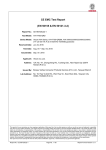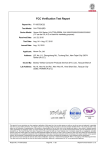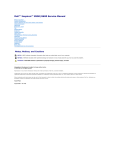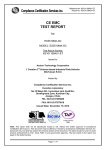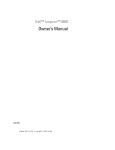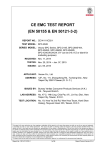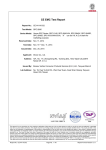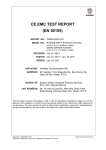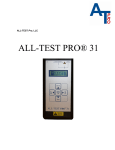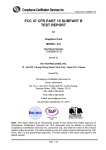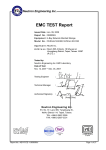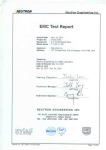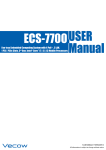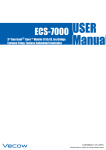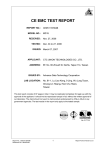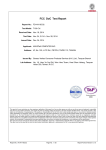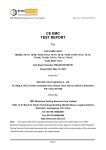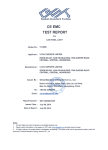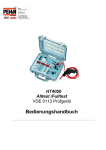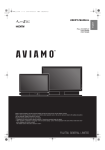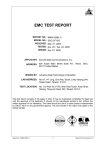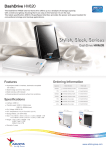Download CE EMC Test Report
Transcript
CE EMC Test Report Report No.: CE150723C22 Test Model: IVH-7700-QRD Series Model: Vecow IVH Series, IVH-7700-QRDM, IVH-XXXXXXXXXXXXXXXXXXXX (“X” can be 0-9, A-Z or blank for marketing purpose) Received Date: Jul. 23, 2015 Test Date: Aug. 04 ~ Sep. 04, 2015 Issued Date: Sep. 04, 2015 Applicant: Vecow Co.,Ltd. Address: 12F.,No. 111, Zhongcheng Rd., Tucheng Dist., New Taipei City 23674 Taiwan (R.O.C.) Issued By: Bureau Veritas Consumer Products Services (H.K.) Ltd., Taoyuan Branch Lab Address: No. 19, Hwa Ya 2nd Rd., Wen Hwa Vil., Kwei Shan Dist., Taoyuan City 33383, TAIWAN (R.O.C.) This report is for your exclusive use. Any copying or replication of this report to or for any other person or entity, or use of our name or trademark, is permitted only with our prior written permission. This report sets forth our findings solely with respect to the test samples identified herein. The results set forth in this report are not indicative or representative of the quality or characteristics of the lot from which a test sample was taken or any similar or identical product unless specifically and expressly noted. Our report includes all of the tests requested by you and the results thereof based upon the information that you provided to us. You have 60 days from date of issuance of this report to notify us of any material error or omission caused by our negligence, provided, however, that such notice shall be in writing and shall specifically address the issue you wish to raise. A failure to raise such issue within the prescribed time shall constitute your unqualified acceptance of the completeness of this report, the tests conducted and the correctness of the report contents. Unless specific mention, the uncertainty of measurement has been explicitly taken into account to declare the compliance or non-compliance to the specification. The report must not be used by the client to claim product certification, approval, or endorsement by NVLAP, NIST, or any agency of the federal government. The report must not be used by the client to claim product certification, approval, or endorsement by TAF or any government agencies. Report No.: CE150723C22 Page No. 1 / 87 Report Format Version: 6.1.2 Table of Contents Release Control Record .................................................................................................................................. 5 1 Certificate of Conformity ......................................................................................................................... 6 2 Summary of Test Results ........................................................................................................................ 7 2.1 2.2 3 General Information ................................................................................................................................. 9 3.1 3.2 3.3 3.4 3.5 3.6 4 Limits ................................................................................................................................................. 37 Test Instruments ................................................................................................................................ 37 Test Arrangement .............................................................................................................................. 38 Test Results ....................................................................................................................................... 39 Radiated Disturbance above 1 GHz ..................................................................................................... 41 8.1 8.2 8.3 8.4 9 Limits ................................................................................................................................................. 21 Test Instruments ................................................................................................................................ 21 Test Arrangement .............................................................................................................................. 22 Supplementary Information ............................................................................................................... 22 Test Results ...................................................................................................................................... 23 Radiated Disturbance up to 1 GHz ....................................................................................................... 37 7.1 7.2 7.3 7.4 8 Limits ................................................................................................................................................. 17 Test Instruments ................................................................................................................................ 17 Test Arrangement .............................................................................................................................. 18 Test Results ....................................................................................................................................... 19 Conducted Disturbance at Telecommunication Ports ....................................................................... 21 6.1 6.2 6.3 6.4 6.5 7 Connection Diagram of EUT and Peripheral Devices ....................................................................... 13 Configuration of Peripheral Devices and Cable Connections ........................................................... 15 Conducted Disturbance at Mains Ports ............................................................................................... 17 5.1 5.2 5.3 5.4 6 Features of EUT .................................................................................................................................. 9 General Description of EUT ................................................................................................................ 9 Operating Modes of EUT and Determination of Worst Case Operating Mode ................................. 10 Test Program Used and Operation Descriptions ............................................................................... 11 Primary Clock Frequencies of Internal Source ................................................................................. 11 Miscellaneous.................................................................................................................................... 12 Configuration and Connections with EUT........................................................................................... 13 4.1 4.2 5 Measurement Uncertainty ................................................................................................................... 8 Modification Record............................................................................................................................. 8 Limits ................................................................................................................................................. 41 Test Instruments ................................................................................................................................ 42 Test Arrangement .............................................................................................................................. 43 Test Results ....................................................................................................................................... 44 Harmonics Current Measurement ........................................................................................................ 46 9.1 9.2 9.3 9.4 9.5 Limits ................................................................................................................................................. 46 Classification of Equipment ............................................................................................................... 46 Test Instruments ................................................................................................................................ 46 Test Arrangement .............................................................................................................................. 47 Test Results ....................................................................................................................................... 47 10 Voltage Fluctuations and Flicker Measurement ................................................................................. 48 10.1 10.2 10.3 Limits ................................................................................................................................................. 48 Test Instruments ................................................................................................................................ 48 Test Arrangement .............................................................................................................................. 48 Report No.: CE150723C22 Page No. 2 / 87 Report Format Version: 6.1.2 10.4 Test Results ....................................................................................................................................... 49 11 General Immunity Requirements.......................................................................................................... 50 11.1 Performance Criteria ......................................................................................................................... 51 12 Electrostatic Discharge Immunity Test (ESD) ..................................................................................... 53 12.1 12.2 12.3 12.4 Test Specification...............................................................................................................................53 Test Instruments ................................................................................................................................ 53 Test Arrangement .............................................................................................................................. 53 Test Results ....................................................................................................................................... 55 13 Radiated, Radio-frequency, Electromagnetic Field Immunity Test (RS) .......................................... 58 13.1 13.2 13.3 13.4 Test Specification...............................................................................................................................58 Test Instruments ................................................................................................................................ 58 Test Arrangement .............................................................................................................................. 59 Test Results ....................................................................................................................................... 59 14 Electrical Fast Transient/Burst Immunity Test (EFT).......................................................................... 60 14.1 14.2 14.3 14.4 14.5 Test Specification...............................................................................................................................60 Test Instruments ................................................................................................................................ 60 Test Arrangement .............................................................................................................................. 61 Supplementary Information ............................................................................................................... 61 Test Results ....................................................................................................................................... 62 15 Surge Immunity Test .............................................................................................................................. 64 15.1 15.2 15.3 15.4 15.5 Test Specification...............................................................................................................................64 Test Instruments ................................................................................................................................ 64 Test Arrangement .............................................................................................................................. 64 Supplementary Information ............................................................................................................... 66 Test Results ....................................................................................................................................... 66 16 Immunity to Conducted Disturbances Induced by RF Fields (CS) ................................................... 67 16.1 16.2 16.3 16.4 16.5 Test Specification...............................................................................................................................67 Test Instruments ................................................................................................................................ 67 Test Arrangement .............................................................................................................................. 68 Supplementary Information ............................................................................................................... 68 Test Results ....................................................................................................................................... 69 17 Power Frequency Magnetic Field Immunity Test................................................................................ 70 17.1 17.2 17.3 17.4 Test Specification...............................................................................................................................70 Test Instruments ................................................................................................................................ 70 Test Arrangement .............................................................................................................................. 70 Test Results ....................................................................................................................................... 71 18 Voltage Dips and Interruptions ............................................................................................................. 72 18.1 18.2 18.3 18.4 18.5 Test Specification...............................................................................................................................72 Test Instruments ................................................................................................................................ 72 Test Arrangement .............................................................................................................................. 72 Supplementary Information ............................................................................................................... 72 Test Results ....................................................................................................................................... 73 19 Pictures of Test Arrangements ............................................................................................................. 74 19.1 19.2 19.3 19.4 19.5 19.6 Conducted Disturbance at Mains Ports............................................................................................. 74 Conducted Disturbance at Telecommunication Ports ....................................................................... 75 Radiated Disturbance up to 1 GHz ................................................................................................... 76 Radiated Disturbance above 1 GHz.................................................................................................. 77 Harmonics Current, Voltage Fluctuations and Flicker Measurement ................................................ 78 Electrostatic Discharge Immunity Test (ESD) ...................................................................................78 Report No.: CE150723C22 Page No. 3 / 87 Report Format Version: 6.1.2 19.7 19.8 19.9 19.10 19.11 19.12 Radio-frequency, Electromagnetic Field Immunity Test (RS) ............................................................ 79 Electrical Fast Transient/Burst Immunity Test (EFT) ......................................................................... 79 Surge Immunity Test.......................................................................................................................... 82 Conducted Disturbances Induced by RF Fields (CS) ....................................................................... 83 Power Frequency Magnetic Field Immunity Test (PFMF) ................................................................. 86 Voltage Dips and Interruptions .......................................................................................................... 86 Appendix – Information on the Testing Laboratories ................................................................................ 87 Report No.: CE150723C22 Page No. 4 / 87 Report Format Version: 6.1.2 Release Control Record Issue No. Description Date Issued CE150723C22 Original release. Sep. 04, 2015 Report No.: CE150723C22 Page No. 5 / 87 Report Format Version: 6.1.2 1 Certificate of Conformity Product: Brand: Test Model: Series Model: High Performance Fanless In-Vehicle System Vecow IVH-7700-QRD Vecow IVH Series, IVH-7700-QRDM, IVH-XXXXXXXXXXXXXXXXXXXX (“X” can be 0-9, A-Z or blank for marketing purpose) Sample Status: Engineering sample Applicant: Vecow Co.,Ltd. Test Date: Aug. 04 ~ Sep. 04, 2015 Standards: EN 55022:2010 +AC:2011, Class A EN 61000-3-2:2014, Class A EN 61000-3-3:2013 EN 55024:2010 EN 61000-4-2:2009 EN 61000-4-3:2006 +A1:2008 +A2:2010 EN 61000-4-4:2012 EN 61000-4-5:2006 EN 61000-4-6:2014 EN 61000-4-8:2010 EN 61000-4-11:2004 The above equipment has been tested by Bureau Veritas Consumer Products Services (H.K.) Ltd., Taoyuan Branch, and found compliance with the requirement of the above standards. The test record, data evaluation & Equipment Under Test (EUT) configurations represented herein are true and accurate accounts of the measurements of the sample’s EMC characteristics under the conditions specified in this report. Prepared by : , Date: Sep. 04, 2015 , Date: Sep. 04, 2015 Suntee Liu / Specialist Approved by : Ken Liu / Senior Manager Report No.: CE150723C22 Page No. 6 / 87 Report Format Version: 6.1.2 2 Summary of Test Results Standard Clause EN 55022:2010 +AC:2011 5.1 EN 55022:2010 +AC:2011 5.2 EN 55022:2010 +AC:2011 6.1 EN 55022:2010 +AC:2011 6.2 Emission Test Item Mains terminal disturbance voltage Conducted common mode (asymmetric mode) disturbance at telecommunication ports Radiated disturbance 30-1000 MHz Radiated disturbance above 1GHz EN 61000-3-2:2014 - Harmonic current emissions EN 61000-3-3:2013 - Voltage fluctuations and flicker Result/Remarks Minimum passing Class A margin is -8.14 dB at 0.16096 MHz Minimum passing Class A margin is -1.05 dB at 2.08936 MHz Minimum passing Class A margin is -4.42 dB at 85.83 MHz Minimum passing Class A margin is -16.78 dB at 2999.97 MHz Class A The power consumption of EUT is less than 75W and no limits apply dmax ≦ 4% Pst ≦ 1.0 Plt ≦ 0.65 dc ≦ 3.3% Tmax ≦ 500ms Verdict Pass Pass Pass Pass Pass Pass Immunity EN 55024 Clause 4.2.1 4.2.3.2 4.2.2 4.2.5 Basic standard EN 61000-4-2:2009 EN 61000-4-3:2006 +A1:2008 +A2:2010 EN 61000-4-4:2004 EN 61000-4-4:2012* EN 61000-4-5:2006 4.2.3.3 EN 61000-4-6:2009 EN 61000-4-6:2014* 4.2.4 EN 61000-4-8:2010 Test Item Electrostatic discharges (ESD) Continuous radiated disturbances (RS) Electrical fast transients (EFT) Surges Continuous conducted disturbances (CS) Power-frequency magnetic fields (PFMF) Result/Remarks Verdict Performance Criterion B Pass Performance Criterion A Pass Performance Criterion B Pass Performance Criterion A Pass Performance Criterion A Pass Performance Criterion A Pass Voltage Dips: >95% reduction – 0.5 period, Performance Criterion A Voltage dips and 30% reduction – 25 periods, Pass 4.2.6 EN 61000-4-11:2004 interruptions Performance Criterion A Voltage Interruptions: >95% reduction – 250 periods, Performance Criterion C * Both of specific and the latest version of the basic standard are referenced to fulfill the requirements. Note: There is no deviation to the applied test methods and requirements covered by the scope of this report. Report No.: CE150723C22 Page No. 7 / 87 Report Format Version: 6.1.2 2.1 Measurement Uncertainty Where relevant, the following measurement uncertainty levels have been estimated for tests performed on the EUT as specified in CISPR 16-4-2: The listed uncertainties are the worst case uncertainty for the entire range of measurement. Please note that the uncertainty values are provided for informational purposes only and are not used in determining the PASS/FAIL results. Measurement Expended Uncertainty (k=2) (±) Maximum allowable uncertainty (±) 2.44 dB 3.4 dB (Ucispr) 2.69 dB 5.0 dB (Ucispr) 4.70 dB 2.29 dB 6.3 dB (Ucispr) 5.2 dB (Ucispr) Conducted disturbance at mains port using AMN, 150kHz ~ 30MHz Conducted disturbance at telecommunication port using AAN, 150kHz ~ 30MHz Radiated disturbance, 30MHz ~ 1GHz Radiated disturbance, 1GHz ~ 6GHz 2.2 Modification Record There were no modifications required for compliance. Report No.: CE150723C22 Page No. 8 / 87 Report Format Version: 6.1.2 3 3.1 General Information Features of EUT The tests reported herein were performed according to the method specified by Vecow Co.,Ltd., for detailed feature description, please refer to the manufacturer's specifications or user's manual. 3.2 General Description of EUT Product High Performance Fanless In-Vehicle System Brand Vecow Test Model IVH-7700-QRD Series Model Vecow IVH Series, IVH-7700-QRDM, IVH-XXXXXXXXXXXXXXXXXXXX (“X” can be 0-9, A-Z or blank for marketing purpose) Model Difference Refer to Note Sample Status Engineering sample Operating Software Win 7 Power Supply Rating 24Vdc (adapter) Accessory Device NA Data Cable Supplied NA Note: 1. All models are listed as below. Model IVH-7700-QRD is the representative for final test. Brand Model Difference Vecow IVH Series IVH-7700-QRD All models are electrically identical, IVH-7700-QRDM Vecow different model names are for marketing IVH-XXXXXXXXXXXXXXXXXXXX purpose. (“X” can be 0-9, A-Z or blank for marketing purpose) 2. The EUT tested with following adapter (support unit only). Brand MW Model GS160A24 Input Power 100-240Vac, 50/60Hz, 2.0A Output Power 24Vdc, 6.67Am, 160W MAX. Power Line 1.15m DC cable with 1 core attached on adapter Report No.: CE150723C22 Page No. 9 / 87 Report Format Version: 6.1.2 3.3 Operating Modes of EUT and Determination of Worst Case Operating Mode The EUT is designed with power adapter of rating 100-240Vac, 50/60Hz. For radiated emission up to 1GHz evaluation, 230Vac/50Hz (for EN 55022) & 120Vac/60Hz (for FCC Part 15) had been covered during the pre-test. The worst data was recorded in the applied test report. EUT has been pre-tested under following modes, and mode 6 was the worst case for final test. Mode Test Condition 1 LAN 1~2 1Gbps, LAN 3~6 with camera, DVI 1920*1200, DP 1920*1200, 230Vac/50Hz 2 LAN 1~2 1Gbps, LAN 3~6 with camera, DVI 1280*1024, DP 1280*1024, 230Vac/50Hz 3 LAN 1~2 1Gbps, LAN 3~6 with camera, DVI 800*600, DP 800*600, 230Vac/50Hz 4 LAN 1~2 100Mbps, LAN 3~6 with camera, DVI 1920*1200, DP 1920*1200, 230Vac/50Hz 5 LAN 1~2 10Mbps, LAN 3~6 with camera, DVI 1920*1200, DP 1920*1200, 230Vac/50Hz 6 LAN 1~2 1Gbps, LAN 3~6 with camera, DVI 1920*1200, DP 1920*1200, 120Vac/60Hz Test modes are presented in the report as below. Mode Test Condition Conducted emission test LAN 1~2 1Gbps, LAN 3~6 with camera, DVI 1920*1200, DP 1920*1200 Conducted emission at telecom port test LAN 1 port 10Mbps/100Mbps/1Gbps, DVI 1920*1200, DP 1920*1200 LAN 2 port 10Mbps/100Mbps/1Gbps, DVI 1920*1200, DP 1920*1200 LAN 3 port 10Mbps/100Mbps, DVI 1920*1200, DP 1920*1200 LAN 4 port 10Mbps/100Mbps, DVI 1920*1200, DP 1920*1200 LAN 5 port 10Mbps/100Mbps, DVI 1920*1200, DP 1920*1200 LAN 6 port 10Mbps/100Mbps, DVI 1920*1200, DP 1920*1200 The idle mode of conducted emission test at telecom port was pre-tested based on the worst case of link mode. Due to emissions of idle mode being very low compared to link mode, only the link mode data were presented in the test report. Radiated emission test LAN 1~2 1Gbps, LAN 3~6 with camera, DVI 1920*1200, DP 1920*1200 Harmonics, Flicker, Immunity tests LAN 1~2 1Gbps, LAN 3~6 with camera, DVI 1920*1200, DP 1920*1200 Report No.: CE150723C22 Page No. 10 / 87 Report Format Version: 6.1.2 3.4 Test Program Used and Operation Descriptions Emission tests: a. EUT sent “H” patterns to monitors and monitors displayed them. b. EUT sent “H” patterns to modems. c. EUT read and wrote date with HDDs. d. EUT sent audio signal to earphone. e. EUT sent data to notebooks and cameras through LAN by command PING. Harmonics, Flicker, Immunity tests: a. EUT sent “H” patterns to monitors and monitors displayed them. b. EUT sent “H” patterns to modems. c. EUT read and wrote date with HDDs and flashes. d. EUT sent audio signal to earphone. e. EUT sent data to notebooks and cameras through LAN by command PING. 3.5 Primary Clock Frequencies of Internal Source The highest frequency generated or used within the EUT or on which the EUT operates or tunes is 3.3 GHz provided by Vecow Co.,Ltd., for detailed internal source, please refer to the manufacturer's specifications. Report No.: CE150723C22 Page No. 11 / 87 Report Format Version: 6.1.2 3.6 Miscellaneous Affix CE marking The marking must be placed visibly and legibly on the product or, if not possible due to the nature of the product, be affixed to the packaging and the accompanying document. The CE marking shall consist of the initials 'CE' taking the following form: The various components of the CE marking must have the same vertical dimension, and may not be smaller than 5 mm. If the CE marking is reduced or enlarged, the proportions given in the graduated drawing above must be respected. When the product is subject to other Directives covering other aspects and which also provide for the ‘CE’ marking, the accompanying documents must indicate that the product also conforms to those other Directives. However, when one or more of those Directives allow the manufacturer, during a transitional period, to choose which arrangements to apply, the ‘CE’ marking has to indicate conformity only with the Directives applied by the manufacturer. In this case, the particularities of the Directives applied, as published in the Official Journal of the European Union, must be given in the documents, notices or instructions required by the Directives and accompanying such products. EN 55022 Class A Warning: Class A ITE is a category of all other ITE which satisfies the class A ITE limits but not the class B ITE limits. The following warning shall be included in the instructions for use: Report No.: CE150723C22 Page No. 12 / 87 Report Format Version: 6.1.2 4 4.1 Configuration and Connections with EUT Connection Diagram of EUT and Peripheral Devices Emission tests: Monitor (A) Monitor (B) (1) (2) DP Audio DVI Audio EUT HDD (G,H,I,J,K,L) (7) USB x6 USB Modem (M,N,O,P) (8) RS232 x4 USB Adapter (T) (3) (4) (5) (6) Mic. (C) Earphone (D) Keyboard (E) Mouse (F) DC LAN x2 LAN x4 (9) (10) Remote site Notebook (Q,R) Report No.: CE150723C22 Camera x4 (S) Page No. 13 / 87 Report Format Version: 6.1.2 Immunity tests: Monitor (A) Monitor (B) HDD (F,G,H,I) (1) (2) (6) Flash (J,K) Modem (L,M,N,O) Adapter (S) (7) DP DVI Audio Audio EUT USB x4 USB x2 USB RS232 x4 USB (3) (4) (5) Earphone & Mic. (C) Keyboard (D) Mouse (E) DC LAN x2 LAN x4 (9) (8) Remote site Notebook (P,Q) Report No.: CE150723C22 Camera x4 (R) Page No. 14 / 87 Report Format Version: 6.1.2 4.2 Configuration of Peripheral Devices and Cable Connections Emission tests: ID Product Brand Model No. Serial No. FCC ID CN-0J257M-72872-0A Remarks A. 24" LCD MONITOR DELL U2410 B. 24" LCD MONITOR DELL U2410 C. MICROPHONE Labtec LVA7313 NA NA - D. EARPHONE PHILIPS SBC HL150 NA NA - E. 6-02NL CN-0J257M-72872-0A 6-08JL MY-0DJ325-71619-68 SK-8115 FCC DoC Approved FCC DoC Approved - Keyboard DELL F. MOUSE DELL M056U0 349003901 FCC DoC Approved - G. External Hard Disk WD WDBACY5000ABL WX81E71WXC27 FCC DoC Approved - H. External Hard Disk WD WXS1CC1D3606 FCC DoC Approved - U-1757 WDBACY5000ABL -01 FCC DoC Approved - I. External Hard Disk WD WDBACY5000ABL WX81E71TTS16 FCC DoC Approved - J. External Hard Disk TOSHIBA V63700-B 53E2CFNUTSX4 FCC DoC Approved - K. External Hard Disk TOSHIBA V63700-B 43J4T0EFTTS9 FCC DoC Approved - L. External Hard Disk TOSHIBA V63700-B 53ERP61GTSX4 FCC DoC Approved - M. MODEM ACEEX 1414V/3 0401008246 IFAXDM1414 N. MODEM ACEEX 1414V/3 0401008268 IFAXDM1414 - O. MODEM ACEEX 1414V/3 0401008244 IFAXDM1414 - P. MODEM ACEEX 1414V/3 0401008263 IFAXDM1414 - Q. NB DELL V3560D HGZ5RX1 FCC DoC Approved - R. NB lenovo 20AYA00MTW MP042EKY FCC DoC Approved - S. Camera x4 NA NA NA NA Provided by manufacturer T. Adapter MW GS160A24 NA NA Provided by manufacturer - Note: 1. All power cords of the above support units are non-shielded (1.8m). 2. Items Q~S acted as communication partners to transfer data. ID Descriptions Qty. Length (m) Shielding (Yes/No) Cores (Qty.) Remarks 1. Display 1 1.8 Y 0 2. DVI 1 1.8 Y 2 - 3. Microphone 1 2.2 N 0 - 4. Earphone 1 1.2 N 0 - 5. USB 1 1.8 Y 0 - 6. USB 1 1.8 Y 0 - 7. USB 6 0.5 Y 0 - 8. RS232 4 1.2 Y 0 - 9. RJ45, Cat5e 2 10 N 0 - 10. RJ45, Cat5e 4 10 N 0 - Note: The core(s) is(are) originally attached to the cable(s). Report No.: CE150723C22 Page No. 15 / 87 Report Format Version: 6.1.2 Harmonics, Flicker, Immunity tests: ID Product Brand Model No. A. 24" LCD MONITOR DELL 2407WFPb B. 24" LCD MONITOR DELL 2408FPb C. Earphone & Mic. PHILIPS SHM2100 Serial No. FCC ID CN-0FC255-46633-6 65-07US CN-0G293H-74261874-237S-A00 FCC DoC Approved FCC DoC Approved - NA NA MY-05N456-71679-3 Remarks - D. Keyboard DELL SK-8110 E. MOUSE DELL MS111-P F. External Hard Disk ADATA HV620 1E3620122267 FCC DoC Approved - G. External Hard Disk ADATA HV620 1E3620122271 FCC DoC Approved - C1-1635 CN-011D3V-71581-1 CJ-01A8 FCC DoC Approved FCC DoC Approved - H. External Hard Disk ADATA HV620 1E3620122277 FCC DoC Approved - I. External Hard Disk ADATA HV620 1E3620122297 FCC DoC Approved - J. USB Flash Drive ADATA S102 03 FCC DoC Approved - K. USB Flash Drive ADATA S102 04 FCC DoC Approved - L. MODEM ACEEX 1414V/3 0401008257 IFAXDM1414 - M. MODEM ACEEX 1414V/3 0401008260 IFAXDM1414 - N. MODEM ACEEX 1414V/3 0401008241 IFAXDM1414 - O. MODEM ACEEX 1414V/3 0401008262 IFAXDM1414 - P. Notebook DELL PP02X Q. Notebook DELL PP02X R. Camera x4 NA NA NA NA Provided by manufacturer S. Adapter MW GS160A24 NA NA Provided by manufacturer T7CRDYR7FVTJM WXWHR22PPMH6 Q6KMKR74WGCTY 8GHHGMTQT4J3 QDS-BRCM1005-D QDS-BRCM1005-D - Note: 1. All power cords of the above support units are non-shielded (1.8m). 2. Items P~R acted as communication partners to transfer data. ID Descriptions Qty. Length (m) Shielding (Yes/No) Cores (Qty.) Remarks 1. Display 1 1.8 Y 0 2. DVI 1 1.8 Y 2 - 3. Earphone 1 1.8 N 0 - 4. USB 1 1.8 Y 0 - 5. USB 1 1.8 Y 0 - 6. USB 4 0.5 Y 0 - 7. RS232 4 1.2 Y 0 - 8. RJ45, Cat5e 2 3 N 0 - 9. RJ45, Cat5e 4 3 N 0 - Note: The core(s) is(are) originally attached to the cable(s). Report No.: CE150723C22 Page No. 16 / 87 Report Format Version: 6.1.2 5 5.1 Conducted Disturbance at Mains Ports Limits Class A (dBuV) Class B (dBuV) Quasi-peak Average Quasi-peak Average 0.15 - 0.5 79 66 66 - 56 56 - 46 0.50 - 5.0 73 60 56 46 5.0 - 30.0 73 60 60 50 Notes: 1. The lower limit shall apply at the transition frequencies. 2. The limit decreases linearly with the logarithm of the frequency in the range of 0.15 to 0.50 MHz. Frequency (MHz) 5.2 Test Instruments Description & Manufacturer Test Receiver ROHDE & SCHWARZ RF signal cable Woken LISN ROHDE & SCHWARZ (EUT) LISN ROHDE & SCHWARZ (Peripheral) Software ADT Model No. Serial No. Cal. Date Cal. Due ESCI 100613 Nov. 11, 2014 Nov. 10, 2015 5D-FB Cable-cond1-01 Dec. 26, 2014 Dec. 25, 2015 ESH3-Z5 835239/001 Feb. 26, 2015 Feb. 25, 2016 ESH3-Z5 100311 Jul. 24, 2015 Jul. 23, 2016 BV ADT_Cond_ V7.3.7.3 NA NA NA Notes: 1. The calibration interval of the above test instruments is 12 months and the calibrations are traceable to NML/ROC and NIST/USA. 2. The test was performed in HwaYa Shielded Room 1. 3. The VCCI Site Registration No. is C-2040. Report No.: CE150723C22 Page No. 17 / 87 Report Format Version: 6.1.2 5.3 Test Arrangement a. The EUT was placed 0.4 meters from the conducting wall of the shielded room with EUT being connected to the power mains through a line impedance stabilization network (LISN). Other support units were connected to the power mains through another LISN. The two LISNs provide 50 Ohm/ 50uH of coupling impedance for the measuring instrument. b. Both lines of the power mains connected to the EUT were checked for maximum conducted interference. c. The test results of conducted emissions at mains ports are recorded of six worst margins for quasi-peak (mandatory) [and average (if necessary)] values against the limits at frequencies of interest unless the margin is 20 dB or greater. Note: The resolution bandwidth and video bandwidth of test receiver is 9kHz for quasi-peak detection (QP) and average detection (AV) at frequency 0.15MHz-30MHz. V e r tic a l G r o u n d R e fe r e n c e P la n e 40cm T e s t R e c e iv e r EUT 80cm L IS N H o r iz o n ta l G r o u n d R e f e r e n c e P la n e N o t e : 1 .S u p p o r t u n i ts w e r e c o n n e c t e d t o s e c o n d L IS N . 2 . B o t h o f L I S N s ( A M N ) a r e 8 0 c m f r o m E U T a n d a t le a s t 8 0 c m f r o m o t h e r u n its a n d o t h e r m e ta l p l a n e s Report No.: CE150723C22 Page No. 18 / 87 Report Format Version: 6.1.2 5.4 Test Results Frequency Range 150kHz ~ 30MHz Input Power 230 Vac, 50 Hz (System) Tested by Pon Tsai Frequency No 1 2 3 4 5 6 (MHz) 0.15782 0.22038 0.27120 0.78342 6.60932 18.24548 Correction Factor (dB) 0.05 0.06 0.06 0.07 0.30 0.82 Detector Function & Bandwidth Environmental Conditions Test Date Phase Of Power : Line (L) Reading Value Emission Level (dBuV) (dBuV) Q.P. AV. Q.P. AV. 60.55 55.06 60.60 55.11 46.02 27.31 46.08 27.37 40.08 33.47 40.14 33.53 29.27 21.90 29.34 21.97 24.36 20.92 24.66 21.22 30.09 25.02 30.91 25.84 Quasi-Peak (QP) / Average (AV), 9kHz 20℃, 60%RH 2015/8/4 Limit (dBuV) Q.P. AV. 79.00 66.00 79.00 66.00 79.00 66.00 73.00 60.00 73.00 60.00 73.00 60.00 Margin (dB) Q.P. AV. -18.40 -10.89 -32.92 -38.63 -38.86 -32.47 -43.66 -38.03 -48.34 -38.78 -42.09 -34.16 Remarks: 1. Q.P. and AV. are abbreviations of quasi-peak and average individually. 2. The emission levels of other frequencies were very low against the limit. 3. Margin value = Emission level – Limit value 4. Correction factor = Insertion loss + Cable loss 5. Emission Level = Correction Factor + Reading Value Report No.: CE150723C22 Page No. 19 / 87 Report Format Version: 6.1.2 Frequency Range 150kHz ~ 30MHz Input Power 230 Vac, 50 Hz (System) Tested by Pon Tsai Frequency No 1 2 3 4 5 6 (MHz) 0.16096 0.20893 0.26730 0.36913 6.70316 26.01074 Correction Factor (dB) 0.05 0.05 0.05 0.06 0.29 0.81 Detector Function & Bandwidth Environmental Conditions Test Date Phase Of Power : Neutral (N) Reading Value Emission Level (dBuV) (dBuV) Q.P. AV. Q.P. AV. 62.66 57.81 62.71 57.86 44.68 27.45 44.73 27.50 43.06 37.25 43.11 37.30 32.79 26.63 32.85 26.69 25.08 20.42 25.37 20.71 30.61 24.06 31.42 24.87 Quasi-Peak (QP) / Average (AV), 9kHz 20℃, 60%RH 2015/8/4 Limit (dBuV) Q.P. AV. 79.00 66.00 79.00 66.00 79.00 66.00 79.00 66.00 73.00 60.00 73.00 60.00 Margin (dB) Q.P. AV. -16.29 -8.14 -34.27 -38.50 -35.89 -28.70 -46.15 -39.31 -47.63 -39.29 -41.58 -35.13 Remarks: 1. Q.P. and AV. are abbreviations of quasi-peak and average individually. 2. The emission levels of other frequencies were very low against the limit. 3. Margin value = Emission level – Limit value 4. Correction factor = Insertion loss + Cable loss 5. Emission Level = Correction Factor + Reading Value Report No.: CE150723C22 Page No. 20 / 87 Report Format Version: 6.1.2 6 6.1 Conducted Disturbance at Telecommunication Ports Limits For Class A Equipment Voltage Limit (dBuV) Current limits (dBuA) Frequency (MHz) Quasi-peak Average Quasi-peak Average 0.15-0.5 97-87 84-74 53-43 40-30 0.5-30 87 74 43 30 Note: The limits decrease linearly with the logarithm of the frequency in the range 0.15 MHz to 0.5 MHz. For Class B Equipment Voltage Limit (dBuV) Current limits (dBuA) Frequency (MHz) Quasi-peak Average Quasi-peak Average 0.15-0.5 84-74 74-64 40-30 30-20 0.5-30 74 64 30 20 Note: The limits decrease linearly with the logarithm of the frequency in the range 0.15 MHz to 0.5 MHz. 6.2 Test Instruments Description & Manufacturer Test Receiver ROHDE & SCHWARZ RF signal cable Woken LISN ROHDE & SCHWARZ (EUT) LISN ROHDE & SCHWARZ (Peripheral) Software ADT ISN ISN Capacitive Voltage Probe RF Current Probe Model No. Serial No. Cal. Date Cal. Due ESCI 100613 Nov. 11, 2014 Nov. 10, 2015 5D-FB Cable-cond1-01 Dec. 26, 2014 Dec. 25, 2015 ESH3-Z5 835239/001 Feb. 26, 2015 Feb. 25, 2016 ESH3-Z5 100311 Jul. 24, 2015 Jul. 23, 2016 NA NA NA BV ADT_Cond_ V7.3.7.3 FCC-TLISN-T2-02-09 F-071115-1057-1-09 F-CVP-1 F-33-4 091393 100855 82 45 Nov. 27, 2014 Nov. 26, 2015 Jul. 30, 2015 Jul. 29, 2016 Jul. 07, 2015 Jul. 06, 2016 Feb. 26, 2015 Feb. 25, 2016 Note: 1. The calibration interval of the above test instruments is 12 months and the calibrations are traceable to NML/ROC and NIST/USA. 2. The test was performed in HwaYa Shielded Room 1. 3. The VCCI Site Registration No. is T-1653. Report No.: CE150723C22 Page No. 21 / 87 Report Format Version: 6.1.2 6.3 Test Arrangement Method of Annex C.1.1, Using ISNs: a. The EUT is placed 0.4 meters from the conducting wall of the shielded room and connected to ISN directly to reference ground plane. b. If voltage measurement is used, measure voltage at the measurement port of the ISN, correct the reading by adding the ISN voltage division factor, and compare to the voltage limit. c. If current measurement is used, measure current with the current probe and compare to the current limit. A 50 load has to be connected to the measurement port of the ISN during the current measurement. d. It is not necessary to apply the voltage and the current limit if a ISN is used. e. The test results of disturbance at telecommunication ports are recorded of six worst margins for quasi-peak (mandatory) [and average (if necessary)] values against the limits at frequencies of interest unless the margin is 20 dB or greater. Note: The resolution bandwidth and video bandwidth of test receiver is 9kHz for quasi-peak detection (QP) and average detection (AV) at frequency 0.15MHz-30MHz. 6.4 Supplementary Information The condition of LAN utilization in excess of 10 % and sustaining that level for a minimum of 250 ms is created by command TFGEN. Report No.: CE150723C22 Page No. 22 / 87 Report Format Version: 6.1.2 6.5 Test Results Detector Function & Bandwidth Environmental Conditions Test Date Frequency Range 150kHz ~ 30MHz Input Power 230 Vac, 50 Hz (System) Tested by Pon Tsai Test Mode LAN 1 port with ISN (10Mbps, TFGEN) Frequency No 1 2 3 4 5 6 (MHz) 0.21256 0.63520 1.33082 10.00000 18.36669 23.87197 Correction Factor (dB) 9.60 9.37 9.26 9.18 9.29 9.40 Reading Value (dBuV) Q.P. AV. 48.75 48.11 40.34 39.37 43.24 43.04 64.35 49.84 38.80 35.42 41.02 40.84 Emission Level (dBuV) Q.P. AV. 58.35 57.71 49.71 48.74 52.50 52.30 73.53 59.02 48.09 44.71 50.42 50.24 Quasi-Peak (QP) / Average (AV), 9kHz 20℃, 60%RH 2015/8/4 Limit (dBuV) Q.P. AV. 94.10 81.10 87.00 74.00 87.00 74.00 87.00 74.00 87.00 74.00 87.00 74.00 Margin (dB) Q.P. AV. -35.75 -23.39 -37.29 -25.26 -34.50 -21.70 -13.47 -14.98 -38.91 -29.29 -36.58 -23.76 Remarks: 1. Q.P. and AV. are abbreviations of quasi-peak and average individually. 2. The emission levels of other frequencies were very low against the limit. 3. Margin value = Emission level – Limit value 4. Correction factor = Insertion loss + Cable loss 5. Emission Level = Correction Factor + Reading Value Report No.: CE150723C22 Page No. 23 / 87 Report Format Version: 6.1.2 Detector Function & Bandwidth Environmental Conditions Test Date Frequency Range 150kHz ~ 30MHz Input Power 230 Vac, 50 Hz (System) Tested by Pon Tsai Test Mode LAN 1 port with ISN (100Mbps, TFGEN) Frequency No 1 2 3 4 5 6 (MHz) 0.21256 0.63520 1.33082 2.66022 15.08229 17.89358 Correction Factor (dB) 9.60 9.37 9.26 9.19 9.24 9.28 Reading Value (dBuV) Q.P. AV. 49.53 48.67 40.19 39.00 44.63 44.39 43.02 42.22 36.96 17.99 37.87 18.42 Emission Level (dBuV) Q.P. AV. 59.13 58.27 49.56 48.37 53.89 53.65 52.21 51.41 46.20 27.23 47.15 27.70 Quasi-Peak (QP) / Average (AV), 9kHz 20℃, 60%RH 2015/8/4 Limit (dBuV) Q.P. AV. 94.10 81.10 87.00 74.00 87.00 74.00 87.00 74.00 87.00 74.00 87.00 74.00 Margin (dB) Q.P. AV. -34.97 -22.83 -37.44 -25.63 -33.11 -20.35 -34.79 -22.59 -40.80 -46.77 -39.85 -46.30 Remarks: 1. Q.P. and AV. are abbreviations of quasi-peak and average individually. 2. The emission levels of other frequencies were very low against the limit. 3. Margin value = Emission level – Limit value 4. Correction factor = Insertion loss + Cable loss 5. Emission Level = Correction Factor + Reading Value Report No.: CE150723C22 Page No. 24 / 87 Report Format Version: 6.1.2 Detector Function & Bandwidth Environmental Conditions Test Date Frequency Range 150kHz ~ 30MHz Input Power 230 Vac, 50 Hz (System) Tested by Pon Tsai Test Mode LAN 1 port with ISN (1Gbps, TFGEN) Frequency No 1 2 3 4 5 6 (MHz) 0.21226 0.63875 1.33082 2.66022 19.62180 25.99119 Correction Factor (dB) 9.60 9.37 9.26 9.19 9.30 9.46 Reading Value (dBuV) Q.P. AV. 50.20 49.43 40.10 38.93 44.08 43.83 42.10 41.14 34.11 22.00 36.03 22.94 Emission Level (dBuV) Q.P. AV. 59.80 59.03 49.47 48.30 53.34 53.09 51.29 50.33 43.41 31.30 45.49 32.40 Quasi-Peak (QP) / Average (AV), 9kHz 20℃, 60%RH 2015/8/4 Limit (dBuV) Q.P. AV. 94.12 81.12 87.00 74.00 87.00 74.00 87.00 74.00 87.00 74.00 87.00 74.00 Margin (dB) Q.P. AV. -34.31 -22.08 -37.53 -25.70 -33.66 -20.91 -35.71 -23.67 -43.59 -42.70 -41.51 -41.60 Remarks: 1. Q.P. and AV. are abbreviations of quasi-peak and average individually. 2. The emission levels of other frequencies were very low against the limit. 3. Margin value = Emission level – Limit value 4. Correction factor = Insertion loss + Cable loss 5. Emission Level = Correction Factor + Reading Value Report No.: CE150723C22 Page No. 25 / 87 Report Format Version: 6.1.2 Detector Function & Bandwidth Environmental Conditions Test Date Frequency Range 150kHz ~ 30MHz Input Power 230 Vac, 50 Hz (System) Tested by Pon Tsai Test Mode LAN 2 port with ISN (10Mbps, TFGEN) Frequency No 1 2 3 4 5 6 (MHz) 0.21256 1.33082 2.66022 7.92308 10.00000 20.25913 Correction Factor (dB) 9.60 9.26 9.19 9.17 9.18 9.32 Reading Value (dBuV) Q.P. AV. 49.06 48.30 44.69 44.37 42.81 41.93 45.24 44.02 63.89 49.64 41.87 38.52 Emission Level (dBuV) Q.P. AV. 58.66 57.90 53.95 53.63 52.00 51.12 54.41 53.19 73.07 58.82 51.19 47.84 Quasi-Peak (QP) / Average (AV), 9kHz 20℃, 60%RH 2015/8/4 Limit (dBuV) Q.P. AV. 94.10 81.10 87.00 74.00 87.00 74.00 87.00 74.00 87.00 74.00 87.00 74.00 Margin (dB) Q.P. AV. -35.44 -23.20 -33.05 -20.37 -35.00 -22.88 -32.59 -20.81 -13.93 -15.18 -35.81 -26.16 Remarks: 1. Q.P. and AV. are abbreviations of quasi-peak and average individually. 2. The emission levels of other frequencies were very low against the limit. 3. Margin value = Emission level – Limit value 4. Correction factor = Insertion loss + Cable loss 5. Emission Level = Correction Factor + Reading Value Report No.: CE150723C22 Page No. 26 / 87 Report Format Version: 6.1.2 Detector Function & Bandwidth Environmental Conditions Test Date Frequency Range 150kHz ~ 30MHz Input Power 230 Vac, 50 Hz (System) Tested by Pon Tsai Test Mode LAN 2 port with ISN (100Mbps, TFGEN) Frequency No 1 2 3 4 5 6 (MHz) 0.21256 1.33082 2.66022 7.92308 16.22792 23.06651 Correction Factor (dB) 9.60 9.26 9.19 9.17 9.26 9.38 Reading Value (dBuV) Q.P. AV. 49.41 48.78 43.64 43.40 42.22 41.27 43.65 41.45 45.80 39.75 42.24 32.97 Emission Level (dBuV) Q.P. AV. 59.01 58.38 52.90 52.66 51.41 50.46 52.82 50.62 55.06 49.01 51.62 42.35 Quasi-Peak (QP) / Average (AV), 9kHz 20℃, 60%RH 2015/8/4 Limit (dBuV) Q.P. AV. 94.10 81.10 87.00 74.00 87.00 74.00 87.00 74.00 87.00 74.00 87.00 74.00 Margin (dB) Q.P. AV. -35.09 -22.72 -34.10 -21.34 -35.59 -23.54 -34.18 -23.38 -31.94 -24.99 -35.38 -31.65 Remarks: 1. Q.P. and AV. are abbreviations of quasi-peak and average individually. 2. The emission levels of other frequencies were very low against the limit. 3. Margin value = Emission level – Limit value 4. Correction factor = Insertion loss + Cable loss 5. Emission Level = Correction Factor + Reading Value Report No.: CE150723C22 Page No. 27 / 87 Report Format Version: 6.1.2 Detector Function & Bandwidth Environmental Conditions Test Date Frequency Range 150kHz ~ 30MHz Input Power 230 Vac, 50 Hz (System) Tested by Pon Tsai Test Mode LAN 2 port with ISN (1Gbps, TFGEN) Frequency No 1 2 3 4 5 6 (MHz) 0.21256 0.63856 1.33082 2.66022 7.92308 20.19657 Correction Factor (dB) 9.60 9.37 9.26 9.19 9.17 9.31 Reading Value (dBuV) Q.P. AV. 49.59 48.70 40.03 38.72 44.53 44.29 42.98 42.18 42.12 40.30 36.97 31.69 Emission Level (dBuV) Q.P. AV. 59.19 58.30 49.40 48.09 53.79 53.55 52.17 51.37 51.29 49.47 46.28 41.00 Quasi-Peak (QP) / Average (AV), 9kHz 20℃, 60%RH 2015/8/4 Limit (dBuV) Q.P. AV. 94.10 81.10 87.00 74.00 87.00 74.00 87.00 74.00 87.00 74.00 87.00 74.00 Margin (dB) Q.P. AV. -34.91 -22.80 -37.60 -25.91 -33.21 -20.45 -34.83 -22.63 -35.71 -24.53 -40.72 -33.00 Remarks: 1. Q.P. and AV. are abbreviations of quasi-peak and average individually. 2. The emission levels of other frequencies were very low against the limit. 3. Margin value = Emission level – Limit value 4. Correction factor = Insertion loss + Cable loss 5. Emission Level = Correction Factor + Reading Value Report No.: CE150723C22 Page No. 28 / 87 Report Format Version: 6.1.2 Detector Function & Bandwidth Environmental Conditions Test Date Frequency Range 150kHz ~ 30MHz Input Power 230 Vac, 50 Hz (System) Tested by Pon Tsai Test Mode LAN 3 port with ISN (10Mbps, TFGEN) Frequency No 1 2 3 4 5 6 (MHz) 0.20893 0.83425 1.87822 2.08756 2.71496 10.00000 Correction Factor (dB) 9.60 9.33 9.21 9.20 9.19 9.18 Reading Value (dBuV) Q.P. AV. 69.52 66.41 58.12 57.88 61.88 61.78 63.62 63.60 61.73 61.33 54.51 36.28 Emission Level (dBuV) Q.P. AV. 79.12 76.01 67.45 67.21 71.09 70.99 72.82 72.80 70.92 70.52 63.69 45.46 Quasi-Peak (QP) / Average (AV), 9kHz 20℃, 60%RH 2015/8/4 Limit (dBuV) Q.P. AV. 94.25 81.25 87.00 74.00 87.00 74.00 87.00 74.00 87.00 74.00 87.00 74.00 Margin (dB) Q.P. AV. -15.12 -5.23 -19.55 -6.79 -15.91 -3.01 -14.18 -1.20 -16.08 -3.48 -23.31 -28.54 Remarks: 1. Q.P. and AV. are abbreviations of quasi-peak and average individually. 2. The emission levels of other frequencies were very low against the limit. 3. Margin value = Emission level – Limit value 4. Correction factor = Insertion loss + Cable loss 5. Emission Level = Correction Factor + Reading Value Report No.: CE150723C22 Page No. 29 / 87 Report Format Version: 6.1.2 Detector Function & Bandwidth Environmental Conditions Test Date Frequency Range 150kHz ~ 30MHz Input Power 230 Vac, 50 Hz (System) Tested by Pon Tsai Test Mode LAN 3 port with ISN (100Mbps, TFGEN) Frequency No 1 2 3 4 5 6 (MHz) 0.21010 0.62689 0.83425 1.87922 2.08936 2.71496 Correction Factor (dB) 9.60 9.37 9.33 9.21 9.20 9.19 Reading Value (dBuV) Q.P. AV. 69.74 66.30 56.55 56.50 57.26 57.10 62.03 61.61 64.10 63.75 61.69 61.58 Emission Level (dBuV) Q.P. AV. 79.34 75.90 65.92 65.87 66.59 66.43 71.24 70.82 73.30 72.95 70.88 70.77 Quasi-Peak (QP) / Average (AV), 9kHz 20℃, 60%RH 2015/8/4 Limit (dBuV) Q.P. AV. 94.20 81.20 87.00 74.00 87.00 74.00 87.00 74.00 87.00 74.00 87.00 74.00 Margin (dB) Q.P. AV. -14.86 -5.30 -21.08 -8.13 -20.41 -7.57 -15.76 -3.18 -13.70 -1.05 -16.12 -3.23 Remarks: 1. Q.P. and AV. are abbreviations of quasi-peak and average individually. 2. The emission levels of other frequencies were very low against the limit. 3. Margin value = Emission level – Limit value 4. Correction factor = Insertion loss + Cable loss 5. Emission Level = Correction Factor + Reading Value Report No.: CE150723C22 Page No. 30 / 87 Report Format Version: 6.1.2 Detector Function & Bandwidth Environmental Conditions Test Date Frequency Range 150kHz ~ 30MHz Input Power 230 Vac, 50 Hz (System) Tested by Pon Tsai Test Mode LAN 4 port with ISN (10Mbps, TFGEN) Frequency No 1 2 3 4 5 6 (MHz) 0.21256 0.41670 0.83425 2.08936 2.71496 10.00000 Correction Factor (dB) 9.60 9.46 9.33 9.20 9.19 9.18 Reading Value (dBuV) Q.P. AV. 68.90 66.19 57.63 57.56 58.12 57.90 62.97 62.64 61.78 61.56 54.04 35.82 Emission Level (dBuV) Q.P. AV. 78.50 75.79 67.09 67.02 67.45 67.23 72.17 71.84 70.97 70.75 63.22 45.00 Quasi-Peak (QP) / Average (AV), 9kHz 20℃, 60%RH 2015/8/4 Limit (dBuV) Q.P. AV. 94.10 81.10 88.51 75.51 87.00 74.00 87.00 74.00 87.00 74.00 87.00 74.00 Margin (dB) Q.P. AV. -15.60 -5.31 -21.43 -8.50 -19.55 -6.77 -14.83 -2.16 -16.03 -3.25 -23.78 -29.00 Remarks: 1. Q.P. and AV. are abbreviations of quasi-peak and average individually. 2. The emission levels of other frequencies were very low against the limit. 3. Margin value = Emission level – Limit value 4. Correction factor = Insertion loss + Cable loss 5. Emission Level = Correction Factor + Reading Value Report No.: CE150723C22 Page No. 31 / 87 Report Format Version: 6.1.2 Detector Function & Bandwidth Environmental Conditions Test Date Frequency Range 150kHz ~ 30MHz Input Power 230 Vac, 50 Hz (System) Tested by Pon Tsai Test Mode LAN 4 port with ISN (100Mbps, TFGEN) Frequency No 1 2 3 4 5 6 (MHz) 0.21059 0.41979 0.83425 1.87822 2.08936 2.71496 Correction Factor (dB) 9.60 9.46 9.33 9.21 9.20 9.19 Reading Value (dBuV) Q.P. AV. 69.86 66.42 56.32 56.06 57.62 57.51 61.16 61.08 63.70 63.67 61.90 61.84 Emission Level (dBuV) Q.P. AV. 79.46 76.02 65.78 65.52 66.95 66.84 70.37 70.29 72.90 72.87 71.09 71.03 Quasi-Peak (QP) / Average (AV), 9kHz 20℃, 60%RH 2015/8/4 Limit (dBuV) Q.P. AV. 94.18 81.18 88.45 75.45 87.00 74.00 87.00 74.00 87.00 74.00 87.00 74.00 Margin (dB) Q.P. AV. -14.72 -5.16 -22.68 -9.94 -20.05 -7.16 -16.63 -3.71 -14.10 -1.13 -15.91 -2.97 Remarks: 1. Q.P. and AV. are abbreviations of quasi-peak and average individually. 2. The emission levels of other frequencies were very low against the limit. 3. Margin value = Emission level – Limit value 4. Correction factor = Insertion loss + Cable loss 5. Emission Level = Correction Factor + Reading Value Report No.: CE150723C22 Page No. 32 / 87 Report Format Version: 6.1.2 Detector Function & Bandwidth Environmental Conditions Test Date Frequency Range 150kHz ~ 30MHz Input Power 230 Vac, 50 Hz (System) Tested by Pon Tsai Test Mode LAN 5 port with ISN (10Mbps, TFGEN) Frequency No 1 2 3 4 5 6 (MHz) 0.21059 1.87822 2.08936 2.71496 2.92219 10.00000 Correction Factor (dB) 9.60 9.21 9.20 9.19 9.19 9.18 Reading Value (dBuV) Q.P. AV. 70.14 66.73 61.80 61.67 62.93 62.56 61.63 61.41 60.10 59.74 58.82 40.46 Emission Level (dBuV) Q.P. AV. 79.74 76.33 71.01 70.88 72.13 71.76 70.82 70.60 69.29 68.93 68.00 49.64 Quasi-Peak (QP) / Average (AV), 9kHz 20℃, 60%RH 2015/8/4 Limit (dBuV) Q.P. AV. 94.18 81.18 87.00 74.00 87.00 74.00 87.00 74.00 87.00 74.00 87.00 74.00 Margin (dB) Q.P. AV. -14.44 -4.85 -15.99 -3.12 -14.87 -2.24 -16.18 -3.40 -17.71 -5.07 -19.00 -24.36 Remarks: 1. Q.P. and AV. are abbreviations of quasi-peak and average individually. 2. The emission levels of other frequencies were very low against the limit. 3. Margin value = Emission level – Limit value 4. Correction factor = Insertion loss + Cable loss 5. Emission Level = Correction Factor + Reading Value Report No.: CE150723C22 Page No. 33 / 87 Report Format Version: 6.1.2 Detector Function & Bandwidth Environmental Conditions Test Date Frequency Range 150kHz ~ 30MHz Input Power 230 Vac, 50 Hz (System) Tested by Pon Tsai Test Mode LAN 5 port with ISN (100Mbps, TFGEN) Frequency No 1 2 3 4 5 6 (MHz) 0.21059 0.62689 0.83425 1.87822 2.08736 2.71496 Correction Factor (dB) 9.60 9.37 9.33 9.21 9.20 9.19 Reading Value (dBuV) Q.P. AV. 69.84 66.41 56.39 56.23 57.46 57.40 61.26 61.22 63.58 63.56 61.57 61.53 Emission Level (dBuV) Q.P. AV. 79.44 76.01 65.76 65.60 66.79 66.73 70.47 70.43 72.78 72.76 70.76 70.72 Quasi-Peak (QP) / Average (AV), 9kHz 20℃, 60%RH 2015/8/4 Limit (dBuV) Q.P. AV. 94.18 81.18 87.00 74.00 87.00 74.00 87.00 74.00 87.00 74.00 87.00 74.00 Margin (dB) Q.P. AV. -14.74 -5.17 -21.24 -8.40 -20.21 -7.27 -16.53 -3.57 -14.22 -1.24 -16.24 -3.28 Remarks: 1. Q.P. and AV. are abbreviations of quasi-peak and average individually. 2. The emission levels of other frequencies were very low against the limit. 3. Margin value = Emission level – Limit value 4. Correction factor = Insertion loss + Cable loss 5. Emission Level = Correction Factor + Reading Value Report No.: CE150723C22 Page No. 34 / 87 Report Format Version: 6.1.2 Detector Function & Bandwidth Environmental Conditions Test Date Frequency Range 150kHz ~ 30MHz Input Power 230 Vac, 50 Hz (System) Tested by Pon Tsai Test Mode LAN 6 port with ISN (10Mbps, TFGEN) Frequency No 1 2 3 4 5 6 (MHz) 0.21256 0.83425 1.87822 2.08936 2.71496 10.00000 Correction Factor (dB) 9.60 9.33 9.21 9.20 9.19 9.18 Reading Value (dBuV) Q.P. AV. 68.82 66.15 57.51 57.77 61.60 61.56 63.27 63.02 62.10 61.91 57.71 39.36 Emission Level (dBuV) Q.P. AV. 78.42 75.75 66.84 67.10 70.81 70.77 72.47 72.22 71.29 71.10 66.89 48.54 Quasi-Peak (QP) / Average (AV), 9kHz 20℃, 60%RH 2015/8/4 Limit (dBuV) Q.P. AV. 94.10 81.10 87.00 74.00 87.00 74.00 87.00 74.00 87.00 74.00 87.00 74.00 Margin (dB) Q.P. AV. -15.68 -5.35 -20.16 -6.90 -16.19 -3.23 -14.53 -1.78 -15.71 -2.90 -20.11 -25.46 Remarks: 1. Q.P. and AV. are abbreviations of quasi-peak and average individually. 2. The emission levels of other frequencies were very low against the limit. 3. Margin value = Emission level – Limit value 4. Correction factor = Insertion loss + Cable loss 5. Emission Level = Correction Factor + Reading Value Report No.: CE150723C22 Page No. 35 / 87 Report Format Version: 6.1.2 Detector Function & Bandwidth Environmental Conditions Test Date Frequency Range 150kHz ~ 30MHz Input Power 230 Vac, 50 Hz (System) Tested by Pon Tsai Test Mode LAN 6 port with ISN (100Mbps, TFGEN) Frequency No 1 2 3 4 5 6 (MHz) 0.21115 0.62689 0.83425 1.87822 2.08936 2.71496 Correction Factor (dB) 9.60 9.37 9.33 9.21 9.20 9.19 Reading Value (dBuV) Q.P. AV. 69.78 66.48 56.41 56.40 57.40 57.36 61.22 61.20 63.38 63.16 61.58 61.50 Emission Level (dBuV) Q.P. AV. 79.38 76.08 65.78 65.77 66.73 66.69 70.43 70.41 72.58 72.36 70.77 70.69 Quasi-Peak (QP) / Average (AV), 9kHz 20℃, 60%RH 2015/8/4 Limit (dBuV) Q.P. AV. 94.16 81.16 87.00 74.00 87.00 74.00 87.00 74.00 87.00 74.00 87.00 74.00 Margin (dB) Q.P. AV. -14.78 -5.08 -21.22 -8.23 -20.27 -7.31 -16.57 -3.59 -14.42 -1.64 -16.23 -3.31 Remarks: 1. Q.P. and AV. are abbreviations of quasi-peak and average individually. 2. The emission levels of other frequencies were very low against the limit. 3. Margin value = Emission level – Limit value 4. Correction factor = Insertion loss + Cable loss 5. Emission Level = Correction Factor + Reading Value Report No.: CE150723C22 Page No. 36 / 87 Report Format Version: 6.1.2 7 Radiated Disturbance up to 1 GHz 7.1 Limits Class A (at 10m) Class B (at 10m) dBuV/m dBuV/m 30 - 230 40 30 230 - 1000 47 37 Notes: 1. The lower limit shall apply at the transition frequencies. 2. Emission level (dBuV/m) = 20 log Emission level (uV/m). 3. All emanations from a class A/B digital device or system, including any network of conductors and apparatus connected thereto, shall not exceed the level of field strengths specified above. Frequency (MHz) 7.2 Test Instruments Description & Manufacturer Test Receiver ROHDE & SCHWARZ (V) Test Receiver ROHDE & SCHWARZ (H) BILOG Antenna SCHWARZBECK (V) BILOG Antenna SCHWARZBECK (H) Preamplifier Agilent (V) Preamplifier Agilent (H) Preamplifier Agilent RF signal cable Woken (V) RF signal cable Woken (H) Software BV ADT Antenna Tower (V) Antenna Tower (H) Turn Table Controller (V) Controller (H) Model No. Serial No. ESR 101240 Sep. 29, 2014 Sep. 28, 2015 ESR 101264 Dec. 04, 2014 Dec. 03, 2015 VULB9168 9168-149 Feb. 03, 2015 Feb. 02, 2016 VULB9168 9168-154 Feb. 03, 2015 Feb. 02, 2016 8447D 2944A10636 Oct. 18, 2014 Oct. 17, 2015 8447D 2944A10637 Oct. 18, 2014 Oct. 17, 2015 8449B 3008A01959 Oct. 17, 2015 Oct. 17, 2015 8D-FB Cable-CH(V)-01 Oct. 24, 2015 Oct. 24, 2015 8D-FB Cable-CH(H)-01 Oct. 24, 2015 Oct. 24, 2015 NA NA NA 9707 970705 50303 074 08093 NA NA NA NA NA NA NA NA NA NA BV ADT_Radiated_ V 8.7.07 MFA-440 MFA-440 DS430 MF7802 MF7802 Cal. Date Cal. Due Note: 1. The calibration interval of the above test instruments is 12 months and the calibrations are traceable to NML/ROC and NIST/USA. 2. The test was performed in HwaYa Chamber 1. 3. The FCC Site Registration No. is 477732. 4. The IC Site Registration No. is IC 7450F-1. 5. The VCCI Site Registration No. is R-1893. Report No.: CE150723C22 Page No. 37 / 87 Report Format Version: 6.1.2 7.3 Test Arrangement a. The EUT was placed on the top of a rotating table 0.8 meters above the ground at an accredited test facility. The table was rotated 360 degrees to determine the position of the highest radiation. b. The EUT was set 10 meters away from the interference-receiving antenna, which was mounted on the top of a variable-height antenna tower. c. The antenna is a broadband antenna, and its height is varied from one meter to four meters above the ground to determine the maximum value of the field strength. Both horizontal and vertical polarizations of the antenna are set to make the measurement. d. For each suspected emission, the EUT was arranged to its worst case and then the antenna was tuned to heights from 1 meter to 4 meters and the rotatable table was turned from 0 degrees to 360 degrees to find the maximum reading. e. The test-receiver system was set to quasi-peak detect function and specified bandwidth with maximum hold mode when the test frequency is up to 1 GHz. Note: The resolution bandwidth and video bandwidth of test receiver/spectrum analyzer is 120kHz for quasi-peak detection (QP) at frequency up to 1GHz. Report No.: CE150723C22 Page No. 38 / 87 Report Format Version: 6.1.2 7.4 Test Results Frequency Range Environmental Conditions Test Date No Frequency (MHz) 1 2 3 4 5 6 7 8 9 10 11 12 85.83 154.51 172.02 223.19 309.03 463.51 562.51 618.04 772.57 858.42 890.63 927.09 30MHz ~ 1GHz Detector Function & Resolution Bandwidth Quasi-Peak (QP), 120kHz 20℃, 61%RH Tested by Rolan Zheng 2015/8/7 Antenna Polarity & Test Distance : Horizontal at 10 m Emission Antenna Table Limit Margin Level Height Angle (dBuV/m) (dB) (dBuV/m) (m) (Degree) 35.58 QP 40.00 -4.42 4.00 H 199 29.76 QP 40.00 -10.24 4.00 H 53 29.68 QP 40.00 -10.32 3.50 H 130 35.10 QP 40.00 -4.90 3.50 H 81 39.89 QP 47.00 -7.11 4.00 H 260 37.25 QP 47.00 -9.75 2.00 H 178 39.62 QP 47.00 -7.38 2.00 H 315 37.08 QP 47.00 -9.92 1.50 H 66 42.33 QP 47.00 -4.67 1.00 H 259 39.83 QP 47.00 -7.17 3.50 H 148 42.23 QP 47.00 -4.77 1.00 H 28 42.45 QP 47.00 -4.55 1.00 H 245 Raw Value (dBuV) 55.01 43.13 43.74 50.83 51.27 45.25 45.76 41.53 43.88 40.05 41.79 41.24 Correction Factor (dB/m) -19.43 -13.37 -14.06 -15.73 -11.38 -8.00 -6.14 -4.45 -1.55 -0.22 0.44 1.21 Remarks: 1. Emission Level(dBuV/m) = Raw Value(dBuV) + Correction Factor(dB/m) 2. Correction Factor(dB/m) = Antenna Factor (dB/m) + Cable Factor (dB) – Pre-Amplifier Factor (dB) 3. The other emission levels were very low against the limit. 4. Margin value = Emission level – Limit value Report No.: CE150723C22 Page No. 39 / 87 Report Format Version: 6.1.2 Frequency Range Environmental Conditions Test Date No Frequency (MHz) 1 2 3 4 5 6 7 8 9 10 11 60.07 85.83 154.51 172.02 309.03 468.75 532.19 562.51 772.57 890.63 927.10 30MHz ~ 1GHz Detector Function & Resolution Bandwidth Quasi-Peak (QP), 120kHz 20℃, 61%RH Tested by Rolan Zheng 2015/8/7 Antenna Polarity & Test Distance : Vertical at 10 m Emission Antenna Table Limit Margin Level Height Angle (dBuV/m) (dB) (dBuV/m) (m) (Degree) 34.23 QP 40.00 -5.77 2.00 V 48 32.71 QP 40.00 -7.29 2.00 V 340 32.47 QP 40.00 -7.53 2.50 V 325 32.78 QP 40.00 -7.22 2.00 V 344 35.47 QP 47.00 -11.53 4.00 V 124 34.40 QP 47.00 -12.60 1.00 V 309 35.59 QP 47.00 -11.41 1.00 V 319 37.57 QP 47.00 -9.43 3.50 V 325 40.15 QP 47.00 -6.85 4.00 V 262 38.23 QP 47.00 -8.77 3.50 V 164 42.48 QP 47.00 -4.52 2.50 V 245 Raw Value (dBuV) 48.21 51.85 45.18 46.23 46.21 41.70 41.59 43.02 40.52 36.83 39.93 Correction Factor (dB/m) -13.98 -19.14 -12.71 -13.45 -10.74 -7.30 -6.00 -5.45 -0.37 1.40 2.55 Remarks: 1. Emission Level(dBuV/m) = Raw Value(dBuV) + Correction Factor(dB/m) 2. Correction Factor(dB/m) = Antenna Factor (dB/m) + Cable Factor (dB) – Pre-Amplifier Factor (dB) 3. The other emission levels were very low against the limit. 4. Margin value = Emission level – Limit value Report No.: CE150723C22 Page No. 40 / 87 Report Format Version: 6.1.2 8 Radiated Disturbance above 1 GHz 8.1 Limits Class A (dBuV/m) (at 3m) Class B (dBuV/m) (at 3m) Average Peak Average Peak 1 to 3 56 76 50 70 3 to 6 60 80 54 74 Notes: 1. The lower limit shall apply at the transition frequencies. 2. Emission level (dBuV/m) = 20 log Emission level (uV/m). 3. All emanations from a class A/B digital device or system, including any network of conductors and apparatus connected thereto, shall not exceed the level of field strengths specified above. Frequency (GHz) Frequency Range (For unintentional radiators) Highest frequency generated or used in the EUT or on which the EUT operates or tunes (MHz) Below 108 108-500 500-1000 Above 1000 Report No.: CE150723C22 Upper frequency of measurement range (MHz) 1000 2000 5000 Up to 5 times of the highest frequency or 6 GHz, whichever is less Page No. 41 / 87 Report Format Version: 6.1.2 8.2 Test Instruments Description & Manufacturer Test Receiver ROHDE & SCHWARZ Spectrum Analyzer Agilent BILOG Antenna SCHWARZBECK RF signal cable Woken HORN Antenna SCHWARZBECK Preamplifier Agilent (Above 1GHz) RF signal cable ALLTEST Software BV ADT Antenna Tower BV ADT Turn Table BV ADT Controller BV ADT HORN Antenna SCHWARZBECK RF signal cable HUBER+SUHNER RF signal cable HUBER+SUHNER Model No. Serial No. Cal. Date ESR7 101471 Feb. 09, 2015 Feb. 08, 2016 E4446A MY51100039 Aug. 18, 2014 Aug. 17, 2015 VULB9168 9168-157 Feb. 03, 2015 Feb. 02, 2016 8D-FB Cable-CH2-01 BBHA 9120 D 9120D-405 8449B 3008A01961 Mar. 22, 2015 Cal. Due Mar. 21, 2016 Feb. 06, 2015 Feb. 05, 2016 Oct. 18, 2014 Oct. 17, 2015 Cable-CH2-02 (MWX322+MWX221130 Nov. 06, 2014 Nov. 05, 2015 28S0295) JUNFLON BV ADT_Radiated_ V7.6.15.9.4 NA NA NA AT100 AT93021702 NA NA TT100 TT93021702 NA NA SC100 SC93021702 NA NA BBHA 9170 148 SUCOFLEX 102 Cable-CH1-03-38218 Oct. 25, 2014 Oct. 24, 2015 SUCOFLEX 102 Cable-CH1-04-37433 Oct. 25, 2014 Oct. 24, 2015 Feb. 09, 2015 Feb. 08, 2016 Note: 1. The calibration interval of the above test instruments is 12 months and the calibrations are traceable to NML/ROC and NIST/USA. 2. The test was performed in HwaYa Chamber 2. 3. The horn antenna and HP preamplifier (model: 8449B) are used only for the measurement of emission frequency above 1GHz if tested. 4. The FCC Site Registration No. is 686814. 5. The IC Site Registration No. is IC 7450F-2. 6. The VCCI Site Registration No. is G-18. 7. The 3dB beamwidth of the horn antenna is minimum 30 degree (or w = 1.6m at 3m distance) for 1~6 GHz. Report No.: CE150723C22 Page No. 42 / 87 Report Format Version: 6.1.2 8.3 Test Arrangement a. The EUT was placed on the top of a rotating table 0.8 meters above the ground at an accredited chamber room. The table was rotated 360 degrees to determine the position of the highest radiation. b. The EUT was set 3 meters away from the interference-receiving antenna, which was mounted on the top of a variable-height antenna tower. c. The height of antenna can be varied from one meter to four meters, the height of adjustment depends on the EUT height and the antenna 3dB beamwidth both, to detect the maximum value of the field strength. Both horizontal and vertical polarizations of the antenna are set to make the measurement. d. For each suspected emission, the EUT was arranged to its worst case and then the antenna was tuned to heights and the rotatable table was turned from 0 degrees to 360 degrees to find the maximum reading. e. The spectrum analyzer system was set to peak and average detect function and specified bandwidth with maximum hold mode when the test frequency is above 1 GHz. Note: The resolution bandwidth of test receiver/spectrum analyzer is 1MHz and video bandwidth is 3MHz for Peak detection (PK) at frequency above 1GHz. The resolution bandwidth of test receiver/spectrum analyzer is 1 MHz for Average detection (AV) at frequency above 1GHz. Report No.: CE150723C22 Page No. 43 / 87 Report Format Version: 6.1.2 8.4 Test Results Frequency Range 1GHz ~ 6GHz Input Power 230 Vac, 50 Hz (System) Tested by Scott Yang No Frequency (MHz) 1 2 3 4 5 6 1609.98 1609.98 2230.02 2230.02 4980.15 4980.15 Detector Function & Bandwidth Environmental Conditions Test Date Peak (PK) / Average (AV), 1MHz 26℃, 66%RH 2015/8/6 Antenna Polarity & Test Distance : Horizontal at 3 m Emission Antenna Table Limit Margin Level Height Angle (dBuV/m) (dB) (dBuV/m) (m) (Degree) 48.96 PK 76.00 -27.04 1.00 H 165 32.63 AV 56.00 -23.37 1.00 H 165 46.52 PK 76.00 -29.48 1.52 H 158 33.65 AV 56.00 -22.35 1.52 H 158 47.25 PK 80.00 -32.75 2.03 H 54 34.11 AV 60.00 -25.89 2.03 H 54 Raw Value (dBuV) 56.08 39.75 52.29 39.42 44.97 31.83 Correction Factor (dB/m) -7.12 -7.12 -5.77 -5.77 2.28 2.28 Remarks: 1. Emission Level(dBuV/m) = Raw Value(dBuV) + Correction Factor(dB/m) 2. Correction Factor(dB/m) = Antenna Factor (dB/m) + Cable Factor (dB) – Pre-Amplifier Factor (dB) 3. The other emission levels were very low against the limit. 4. Margin value = Emission level – Limit value Report No.: CE150723C22 Page No. 44 / 87 Report Format Version: 6.1.2 Frequency Range 1GHz ~ 6GHz Input Power 230 Vac, 50 Hz (System) Tested by Scott Yang No Frequency (MHz) 1 2 3 4 5 6 1920.02 1920.02 2932.46 2932.46 2999.97 2999.97 Detector Function & Bandwidth Environmental Conditions Test Date Peak (PK) / Average (AV), 1MHz 26℃, 66%RH 2015/8/6 Antenna Polarity & Test Distance : Vertical at 3 m Emission Antenna Table Limit Margin Level Height Angle (dBuV/m) (dB) (dBuV/m) (m) (Degree) 49.51 PK 76.00 -26.49 1.25 V 66 30.26 AV 56.00 -25.74 1.25 V 66 50.27 PK 76.00 -25.73 1.12 V 229 34.75 AV 56.00 -21.25 1.12 V 229 48.52 PK 76.00 -27.48 1.00 V 8 39.22 AV 56.00 -16.78 1.00 V 8 Raw Value (dBuV) 56.23 36.98 53.66 38.14 51.73 42.43 Correction Factor (dB/m) -6.72 -6.72 -3.39 -3.39 -3.21 -3.21 Remarks: 1. Emission Level(dBuV/m) = Raw Value(dBuV) + Correction Factor(dB/m) 2. Correction Factor(dB/m) = Antenna Factor (dB/m) + Cable Factor (dB) – Pre-Amplifier Factor (dB) 3. The other emission levels were very low against the limit. 4. Margin value = Emission level – Limit value Report No.: CE150723C22 Page No. 45 / 87 Report Format Version: 6.1.2 9 Harmonics Current Measurement 9.1 Limits Limits for Class A equipment Limits for Class D equipment Harmonic Max. permissible Harmonic Max. permissible Max. permissible Order harmonics current Order harmonics current per harmonics current n A A n watt mA/W Odd harmonics Odd Harmonics only 3 2.30 3 3.4 2.30 5 1.14 5 1.9 1.14 7 0.77 7 1.0 0.77 9 0.40 9 0.5 0.40 11 0.33 11 0.35 0.33 13 0.21 13 0.30 0.21 15≦n≦39 0.15 x 15/n 15≦n≦39 3.85/n 0.15 x 15/n Even harmonics 2 1.08 4 0.43 6 0.30 8≦n≦40 0.23 x 8/n Notes: 1. Class A and Class D are classified according to section 5 of EN 61000-3-2. 2. According to section 7 of EN 61000-3-2, the above limits for all equipment except for lighting equipment having an active input power > 75 W and no limits apply for equipment with an active input power up to and including 75 W. 9.2 Classification of Equipment The EUT is Class A in accordance with EN 61000-3-2 as follows: Class A Class B Class C Balanced three-phase equipment; Portable tools; Lighting Household appliances excluding Arc welding equipment. equipment as Class D; equipment which is not professional Tools excluding portable tools; Dimmers for incandescent lamps; equipment. Audio equipment; Equipment not specified in one of the three other classes. 9.3 Class D Equipment having a specified power less than or equal to 600 W of the following types: Personal computers and personal computer monitors; Television receivers; Refrigerators and freezers having one or more variable-speed drives to control compressor motor(s). Test Instruments Description & Manufacturer TESEQ 5KVA AC POWER SOURCE/CONDITION UNIT Software Model No. Serial No. NSG 1007/ CCN 1000-1 1323A00070/ 1318A02119 Win2100 V4.5.8 NA Cal. Date Cal. Due Aug. 21, 2014 Aug. 20, 2015 NA NA Notes: 1. The test was performed in Hwa Ya EMS Room. 2. The calibration interval of the above test instruments is 12 months and the calibrations are traceable to NML/ROC and NIST/USA. Report No.: CE150723C22 Page No. 46 / 87 Report Format Version: 6.1.2 9.4 Test Arrangement a. The EUT was placed on the top of a wooden table 0.8 meters above the ground and operated to produce the maximum harmonic components under normal operating conditions for each successive harmonic component in turn. b. The correspondent test program of test instrument to measure the current harmonics emanated from EUT is chosen. The measure time shall be not less than the time necessary for the EUT to be exercised. EUT 9.5 Test Results Test Duration (mins) Fundamental Voltage/Ampere Power Consumption Environmental Conditions 3 228.29 Vrms/ 0.371 Arms 69.5 W 25 °C, 55% RH Test Date 2015/8/13 Power Frequency 50 Hz Power Factor Tested by 0.848 Vincent Yang Note: 1. Limits are not specified for equipment with a rated power of 75W or less (other than lighting equipment). 2. According to EN 61000-3-2 the manufacturer shall specify the power of the apparatus. This value shall be used for establishing limits. The specified power shall be within +/-10% of the measured power. Report No.: CE150723C22 Page No. 47 / 87 Report Format Version: 6.1.2 10 Voltage Fluctuations and Flicker Measurement 10.1 Limits Test item Pst Plt Limit 1.0 0.65 Tmax (ms) 500 dmax (%) 4 dc (%) 3.3 Note Pst: short-term flicker severity. Plt: long-term flicker severity. Tmax: maximum time duration during the observation period that the voltage deviation d(t) exceeds the limit for dc . dmax: maximum absolute voltage change during an observation period. dc: maximum steady state voltage change during an observation period. 10.2 Test Instruments Description & Manufacturer TESEQ 5KVA AC POWER SOURCE/CONDITION UNIT Software Model No. Serial No. NSG 1007/ CCN 1000-1 1323A00070/ 1318A02119 Win2100 V4.5.8 NA Cal. Date Cal. Due Aug. 21, 2014 Aug. 20, 2015 NA NA Notes: 1. The test was performed in Hwa Ya EMS Room. 2. The calibration interval of the above test instruments is 12 months and the calibrations are traceable to NML/ROC and NIST/USA. 10.3 Test Arrangement a. The EUT was placed on the top of a wooden table 0.8 meters above the ground and operated to produce the most unfavorable sequence of voltage changes under normal operating conditions. b. During the flick measurement, the measure time shall include that part of whole operation cycle in which the EUT produce the most unfavorable sequence of voltage changes. The observation period for short-term flicker indicator is 10 minutes and the observation period for long-term flicker indicator is 2 hours. EUT Report No.: CE150723C22 Page No. 48 / 87 Report Format Version: 6.1.2 10.4 Test Results Observation (Tp) Fundamental Voltage/Ampere 120 min. 228.16 Vrms/ 0.371 Arms Power Consumption 69.5 W Environmental Conditions 25 °C, 55% RH Test Date 2015/8/13 Power Frequency 50 Hz Power Factor Tested by 0.848 Vincent Yang Test Parameter Measurement Value Limit Pst 0.153 1.00 Plt 0.082 0.65 Tmax (ms) 0 500 dmax (%) 0.22 4 dc (%) 0 3.3 Note: (1) Pst means short-term flicker indicator. (2) Plt means long-term flicker indicator. (3) Tmax means accumulated time value of d(t) with a deviation exceeding 3.3 %. (4) dmax means maximum relative voltage change. (5) dc means maximum relative steady-state voltage change. Report No.: CE150723C22 Page No. 49 / 87 Remarks Pass Pass Pass Pass Pass Report Format Version: 6.1.2 11 General Immunity Requirements EN 55024:2010, Immunity requirements Clause 4.2.1 4.2.3.2 Reference standard EN 61000-4-2 ESD EN 61000-4-3 RS Table 1.3 1.2 2.3 4.2.2 EN 61000-4-4 EFT EN 61000-4-5 Surge Enclosure port: ±8kV Air discharge, ±4kV Contact discharge Enclosure port: 80-1000 MHz, 3V/m, 80% AM (1kHz) Signal ports and telecommunication ports: xDSL equipment: ±0.5kV, 5/50 (Tr/Th) ns, 100kHz others: ±0.5kV, 5/50 (Tr/Th) ns, 5kHz Input DC power port: ±0.5kV, 5/50 (Tr/Th) ns, 5kHz 4.5 Input AC Power ports: ±1kV, 5/50 (Tr/Th) ns, 5kHz 3.2 4.4 B A B 3.3 2.2 4.2.5 Performance Criterion Test specification Signal and telecommunication ports (direct to outdoor cables): 10/700 (5/320) (Tr/Th) μs w/o primary protectors: ±1kV, or with primary protectors fitted: ±4kV Input DC power port (direct to outdoor cables): 1.2/50 (8/20) (Tr/Th) μs Line to earth: ±0.5kV Input AC Power ports: 1.2/50 (8/20) (Tr/Th) μs, Line to line: ±1kV C B Line to earth: ±2kV 4.2.3.3 4.2.4 4.2.6 EN 61000-4-6 CS EN 61000-4-8 PFMF EN 61000-4-11 Dips & Interruptions 2.1 Signal and telecommunication ports(cable length > 3m): 0.15-80 MHz, 3V, 80% AM (1kHz) 3.1 Input DC power port: 0.15-80 MHz, 3V, 80% AM (1kHz) 4.1 Input AC Power ports: 0.15-80 MHz, 3V, 80% AM (1kHz) Enclosure port: 50 or 60 Hz, 1A/m 1.1 4.2 4.3 Input AC Power ports: Voltage Dips: >95% reduction – 0.5 period 30% reduction – 25 periods Input AC Power ports: Voltage Interruptions: >95% reduction – 250 periods Report No.: CE150723C22 Page No. 50 / 87 A A B C C Report Format Version: 6.1.2 11.1 Performance Criteria General Performance Criteria Performance criterion A The equipment shall continue to operate as intended without operator intervention. No degradation of performance or loss of function is allowed below a performance level specified by the manufacturer when the equipment is used as intended. The performance level may be replaced by a permissible loss of performance. If the minimum performance level or the permissible performance loss is not specified by the manufacturer, then either of these may be derived from the product description and documentation, and by what the user may reasonably expect from the equipment if used as intended. Performance criterion B After the test, the equipment shall continue to operate as intended without operator intervention. No degradation of performance or loss of function is allowed, after the application of the phenomena below a performance level specified by the manufacturer, when the equipment is used as intended. The performance level may be replaced by a permissible loss of performance. During the test, degradation of performance is allowed. However, no change of operating state or stored data is allowed to persist after the test. If the minimum performance level (or the permissible performance loss) is not specified by the manufacturer, then either of these may be derived from the product description and documentation, and by what the user may reasonably expect from the equipment if used as intended. Performance criterion C Loss of function is allowed, provided the function is self-recoverable, or can be restored by the operation of the controls by the user in accordance with the manufacturer's instructions. Functions, and/or information stored in non-volatile memory, or protected by a battery backup, shall not be lost. Report No.: CE150723C22 Page No. 51 / 87 Report Format Version: 6.1.2 Product Specific Performance Criteria The particular performance criteria which are specified in the normative annexes of EN 55024 take precedence over the corresponding parts of the general performance criteria. Where particular performance criteria for specific functions are not given, then the general performance criteria shall apply. Function Read, write and storage of data Data display Data input Performance criteria A During the test storage devices shall maintain normal operation both in read/write and in standby conditions. During the test, when seen from the normal viewing distance, the EUT shall operate with no change beyond the manufacturer’s specification, in flicker, colour, focus and jitter (except for the power frequency magnetic field test). During testing unintended input from an input device is not allowed. During testing input devices shall maintain the specified quality image data. Data printing During testing printers shall maintain the specified printing quality and normal operation. Data During testing failures which do not influence the specified operation within the product specification, and which do not prevent automatic recovery are permissible. processing Report No.: CE150723C22 Performance criteria B During and after the test failures which can be recovered by read and write retries are permissible (temporary delay in processing caused by this process is acceptable). Normal operation of the EUT shall be restored after the test, self-recovery to the conditions immediately prior to the application of the test is accepted where this is a normal means of recovery. In these cases, operator response is permitted to re-initialise an operation. Screen disturbances during the application of the test are permissible if they self-recover after removal of the external disturbance. Performance criteria C Failures during test that result in a delay in processing or a system abort, which after testing can be recovered to normal operation by reset or reboot, are permissible. During testing keyboard/mouse "lock up" is not allowed. For EUT with manually inputted data that can be confirmed by reading the display, errors are permissible during testing if they can be recognised by the operator and easily corrected. During testing no degradation of the printing quality beyond the manufacturer’s specification (such as distortion of character(s) or missing pixels) is permissible. A paper feed failure is allowed if after removal of the jammed sheets the job is automatically recovered and there is no loss of printed information. During testing failures which are recovered automatically but cause temporary delay in processing are permissible. Failures during test that result in a delay in processing or a system abort, which after testing can be recovered to normal operation by reset or reboot, are permissible. Page No. 52 / 87 Failures during the test that cannot self-recover after removal of the external disturbance, but which can be recovered after the test to normal operation by reset or reboot are permissible. During testing printing errors or omission of character(s) which require reprinting are permissible. Input/output failures that occur during testing that can be recovered to normal operation after testing by reset or reboot are also permissible. Failures during testing that - result in a delay in processing after the external disturbance is removed, but which can be recovered after testing to normal operation by a reset or reboot - result in a system abort, which can be recovered to normal operation after testing by reset or reboot, - are followed by alarms and can be recovered to normal operation by the operator’s intervention after testing are permissible. Report Format Version: 6.1.2 12 Electrostatic Discharge Immunity Test (ESD) 12.1 Test Specification Basic Standard: Discharge Impedance: Discharge Voltage: Number of Discharge: Discharge Mode: Discharge Period: EN/IEC 61000-4-2 330 ohm / 150 pF Air Discharge: ±2, ±4, ±8kV (Direct) Contact Discharge: ±2, ±4kV (Direct / Indirect) Air – Direct: 10 discharges per location (each polarity) Contact – Direct & Indirect: 25 discharges per location (each polarity) and min. 200 times in total Single Discharge 1-second minimum 12.2 Test Instruments Description & Manufacturer Schaffner ESD generator Model No. NSG 435 Serial No. 6008 Cal. Date Nov. 04, 2014 Cal. Due Nov. 03, 2015 Notes: 1. The test was performed in Hwa Ya ESD Room 4. 2. The calibration interval of the above test instruments is 12 months and the calibrations are traceable to NML/ROC and NIST/USA. 12.3 Test Arrangement The discharges shall be applied in two ways: a. Contact discharges to the conductive surfaces and coupling planes: The EUT shall be exposed to at least 200 discharges, 100 each at negative and positive polarity, at a minimum of four test points. One of the test points shall be subjected to at least 50 indirect discharges to the center of the front edge of the horizontal coupling plane. The remaining three test points shall each receive at least 50 direct contact discharges. If no direct contact test points are available, then at least 200 indirect discharges shall be applied in the indirect mode. Test shall be performed at a maximum repetition rate of one discharge per second. b. Air discharges at slots and apertures and insulating surfaces: On those parts of the EUT where it is not possible to perform contact discharge testing, the equipment should be investigated to identify user accessible points where breakdown may occur. Such points are tested using the air discharge method. This investigation should be restricted to those area normally handled by the user. A minimum of 10 single air discharges shall be applied to the selected test point for each such area. Report No.: CE150723C22 Page No. 53 / 87 Report Format Version: 6.1.2 The basic test procedure was in accordance with EN/IEC 61000-4-2: a. Electrostatic discharges were applied only to those points and surfaces of the EUT that are accessible to users during normal operation. b. The test was performed with at least ten single discharges on the pre-selected points in the most sensitive polarity. c. The time interval between two successive single discharges was at least 1 second. d. The ESD generator was held perpendicularly to the surface to which the discharge was applied and the return cable was at least 0.2 meters from the EUT. e. Contact discharges were applied to the non-insulating coating, with the pointed tip of the generator penetrating the coating and contacting the conducting substrate. f. Air discharges were applied with the round discharge tip of the discharge electrode approaching the EUT as fast as possible (without causing mechanical damage) to touch the EUT. After each discharge, the ESD generator was removed from the EUT and re-triggered for a new single discharge. The test was repeated until all discharges were complete. g. At least ten single discharges (in the most sensitive polarity) were applied to the Horizontal Coupling Plane at points on each side of the EUT. The ESD generator was positioned at a distance of 0.1 meters from the EUT with the discharge electrode touching the HCP. h. At least ten single discharges (in the most sensitive polarity) were applied to the center of one vertical edge of the Vertical Coupling Plane in sufficiently different positions that the four faces of the EUT were completely illuminated. The VCP (dimensions 0.5m x 0.5m) was placed vertically to and 0.1 meters from the EUT. 0.1m 1m Vertical coupling plane 0.5mm Isolation Support EUT ESD Generator 470k X4 Nearest Wall Horizontal coupling plane 80cm PS Reference Ground Plane Table-top Equipment The configuration consisted of a wooden table 0.8 meters high standing on the Ground Reference Plane. The GRP consisted of a sheet of aluminum at least 0.25mm thick, and 2.5 meters square connected to the protective grounding system. A Horizontal Coupling Plane (1.6m x 0.8m) was placed on the table and attached to the GRP by means of a cable with 940k total impedance. The equipment under test, was installed in a representative system as described in section 7 of EN/IEC 61000-4-2, and its cables were placed on the HCP and isolated by an insulating support of 0.5mm thickness. A distance of 1-meter minimum was provided between the EUT and the walls of the laboratory and any other metallic structure. Report No.: CE150723C22 Page No. 54 / 87 Report Format Version: 6.1.2 12.4 Test Results Input Power 24 Vdc Test Date 2015/8/12 Environmental Conditions 24 °C, 55% RH 984 mbar Tested by Tom Tang Test Results of Direct Application Discharge Polarity Performance Test Point Contact Discharge Air Discharge Level (kV) (+/-) Criterion 2 +/1-4 Note 1 NA A 4 +/1-4 Note 2 NA B 2, 4 +/5-6 Note 1 NA A 2, 4 +/7-9 NA Note 1 A 8 +/7-9 NA Note 2 B 2, 4 +/10 NA Note 1 A 8 +/10 NA Note 3 B Description of test points of direct application: Please refer to following page for representative mark only. Test Results of Indirect Application Discharge Polarity Horizontal Vertical Coupling Test Point Level (kV) (+/-) Coupling Plane Plane 2, 4 +/Four Sides Note 1 Note 1 Description of test points of indirect application: 1. Front side 2. Rear side 3. Right side Performance Criterion A 4. Left side Note: 1. The EUT function was correct during the test. 2. The screen showed water line during the test, but could self-recover after the test. 3. The earphone had disturbance noise during the test, but could self-recover after the test. Report No.: CE150723C22 Page No. 55 / 87 Report Format Version: 6.1.2 Description of Test Points 1 7 10 8 3 2 9 4 Report No.: CE150723C22 Page No. 56 / 87 Report Format Version: 6.1.2 5 6 Report No.: CE150723C22 Page No. 57 / 87 Report Format Version: 6.1.2 13 Radiated, Radio-frequency, Electromagnetic Field Immunity Test (RS) 13.1 Test Specification Basic Standard: Frequency Range: Field Strength: Modulation: Frequency Step: Polarity of Antenna: Antenna Height: Dwell Time: EN/IEC 61000-4-3 80 MHz - 1000 MHz 3 V/m, 1kHz Sine Wave, 80%, AM Modulation 1 % of preceding frequency value Horizontal and Vertical 1.55m 3 seconds 13.2 Test Instruments Description & Manufacturer Power Amp ROHDE & SCHWARZ Power Amp ROHDE & SCHWARZ Power Sensor ROHDE & SCHWARZ Power Sensor ROHDE & SCHWARZ Signal Generator ROHDE & SCHWARZ R&S Software LOG ANTENNA Schwarzbeck LOG ANTENNA Amplifier Research ECTRIC FIELD PROBE AR Model No. Serial No. Cal. Date Cal. Due BBA 100 101761 NA NA BBA150 101714 NA NA NRP-Z91 102733 Oct. 13, 2014 Oct. 12, 2015 NRP-Z91 102732 Oct. 13, 2014 Oct. 12, 2015 SMBV100A 260761 Oct. 14, 2014 Oct. 13, 2015 EMC32 Version 9.15.03 NA NA NA STLP9149 9149-280 NA NA AT5080ANT 303730 NA NA FL7006 0338717 May 19, 2015 May 18, 2016 Notes: 1. The test was performed in Hwa Ya RS Room 1. 2. The calibration interval of the above test instruments is 12 months and the calibrations are traceable to NML/ROC and NIST/USA. 3. The transmit antenna was located at a distance of 3 meters from the EUT. Report No.: CE150723C22 Page No. 58 / 87 Report Format Version: 6.1.2 13.3 Test Arrangement The test procedure was in accordance with EN/IEC 61000-4-3. a. The testing was performed in a modified semi-anechoic chamber. b. The frequency range is swept from 80 MHz to 1000 MHz, with the signal 80% amplitude modulated with a 1kHz sine wave. c. The field strength level was 3 V/m. d. The test was performed with the EUT exposed to both vertically and horizontally polarized fields on each of the four sides. EUT RF Amplifier RF Generator and control system Monitoring system Table-top Equipment The EUT installed in a representative system as described in section 7 of EN/IEC 61000-4-3 was placed on a non-conductive table 0.8 meters in height. The system under test was connected to the power and signal wire according to relevant installation instructions. 13.4 Test Results Input Power 24 Vdc Environmental Conditions 24 °C, 58% RH Frequency (MHz) Polarity Azimuth(°) 80 -1000 V&H 0, 90, 180, 270 Test Date 2015/8/27 Tested by Andy Chang Applied Field Strength (V/m) Modulation 3 80% AM (1kHz) Observation Performance Criterion Note 1 A Note: 1. The EUT function was correct during the test. Report No.: CE150723C22 Page No. 59 / 87 Report Format Version: 6.1.2 14 Electrical Fast Transient/Burst Immunity Test (EFT) 14.1 Test Specification Basic Standard: Test Voltage: Impulse Repetition Frequency: Impulse Wave Shape: Burst Duration: Burst Period: Test Duration: EN/IEC 61000-4-4 Signal / telecommunication port: ±0.5kV Input DC power port: ±0.5kV Input AC power port: ±1kV xDSL telecommunication port: 100kHz others: 5kHz 5/50 ns 0.75 ms for 100kHz Repetition Frequency 15 ms for 5kHz Repetition Frequency 300 ms 1 min. 14.2 Test Instruments Description & Manufacturer EMC-Partner EFT Generator EMC-Partner Capacitive Coupling clamp EFT Adapter WONPRO Software Model No. TRA2000 EFT-C1 Serial No. 623 Cal. Date May 14, 2015 Cal. Due May 13, 2016 CN-EFT1000 364 May 14, 2015 May 13, 2016 WA EMC-Partner GENECS EF1Ada-001 NA NA NA NA NA Notes: 1. The test was performed in Hwa Ya EFT Room 1. 2. The calibration interval of the above test instruments is 12 months and the calibrations are traceable to NML/ROC and NIST/USA. Report No.: CE150723C22 Page No. 60 / 87 Report Format Version: 6.1.2 14.3 Test Arrangement a. Both positive and negative polarity discharges were applied. b. The distance between any coupling devices and the EUT should be 0.5 m for table-top equipment testing, and 1.0 m for floor standing equipment. c. The duration time of each test sequential was 1 minute. d. The transient/burst waveform was in accordance with EN/IEC 61000-4-4, 5/50 ns. Note: (A) location for supply line coupling (B) location for signal lines coupling 14.4 Supplementary Information The requirement followed by the manufacturer’s specification. Report No.: CE150723C22 Page No. 61 / 87 Report Format Version: 6.1.2 14.5 Test Results Input Power 24 Vdc Test Date 2015/9/4 Environmental Conditions 24 °C, 65% RH Tested by Josh Lin Input DC power port Voltage (kV) 0.5 0.5 0.5 Test Point L1 L2 L1-L2 Polarity (+/-) +/+/+/- Observation Note 1, 2 Note 1, 2 Note 1, 2 Performance Criterion B B B Polarity (+/-) +/+/+/+/+/+/- Observation Note 3 Note 3 Note 3 Note 3 Note 3 Note 3 Performance Criterion B B B B B B Signal / telecommunication port Voltage (kV) 0.5 0.5 0.5 0.5 0.5 0.5 Test Point LAN 1 LAN 2 LAN 3 LAN 4 LAN 5 LAN 6 Note: 1. The screen showed water line during the test, but could self-recover after the test. 2. The earphone had disturbance noise during the test, but could self-recover after the test. 3. The EUT lost of LAN PING during the test, but could self-recover after the test. Report No.: CE150723C22 Page No. 62 / 87 Report Format Version: 6.1.2 Input Power 230 Vac, 50 Hz (System) Test Date 2015/8/25 Environmental Conditions 24 °C, 65% RH Tested by Josh Lin Input AC power port Voltage (kV) 1 1 1 1 Test Point L1 L2 PE L1-L2-PE Polarity (+/-) +/+/+/+/- Observation Note 1, 2 Note 1, 2 Note 1, 2 Note 1, 2 Performance Criterion B B B B Polarity (+/-) +/+/+/+/+/+/- Observation Note 3 Note 3 Note 3 Note 3 Note 3 Note 3 Performance Criterion B B B B B B Signal / telecommunication port Voltage (kV) 0.5 0.5 0.5 0.5 0.5 0.5 Test Point LAN 1 LAN 2 LAN 3 LAN 4 LAN 5 LAN 6 Note: 1. The screen showed water line during the test, but could self-recover after the test. 2. The earphone had disturbance noise during the test, but could self-recover after the test. 3. The EUT lost of LAN PING during the test, but could self-recover after the test. Report No.: CE150723C22 Page No. 63 / 87 Report Format Version: 6.1.2 15 Surge Immunity Test 15.1 Test Specification Basic Standard: Wave-Shape: EN/IEC 61000-4-5 Signal / telecommunication port (direct to outdoor cables*): 10/700 μs Open Circuit Voltage 5/320 μs Short Circuit Current Input DC power port (direct to outdoor cables*): 1.2/50 μs Open Circuit Voltage 8/20 μs Short Circuit Current Input AC power port: 1.2/50 μs Open Circuit Voltage 8/20 μs Short Circuit Current Test Voltage: Signal and telecommunication ports**: w/o primary protectors: NA, with primary protectors fitted: NA Input DC power port: Line to earth or ground: NA Input AC power ports: Line to line: ±0.5, ±1kV, Line to earth or ground: ±0.5, ±1, ±2kV AC Phase Angle (degree): 0, 90, 180, 270 Pulse Repetition Rate: 1 time / 60 sec. Number of Tests: 5 positive and 5 negative at selected points * This test is only applicable only to ports, which according to the manufacturer's specification, may connect directly to outdoor cables. ** For ports where primary protection is intended, surges are applied at voltages up to 4 kV with the primary protectors fitted. Otherwise the 1 kV test level is applied without primary protection in place. 15.2 Test Instruments Description & Manufacturer Modular Impulse Generator EMC-Partner Universal Surge Coupling De-Coupling Network EMC-Partner Surge Adapter WONPRO Model No. Serial No. Cal. Date MIG0603IN3 IEC-ANSI 352 Sep. 02, 2014 Sep. 01, 2015 CDN-UTP8 011 Sep. 02, 2014 Sep. 01, 2015 WA SU1 Ada-001 NA Cal. Due NA Notes: 1. The test was performed in Hwa Ya Surge Room 2. 2. The calibration interval of the above test instruments is 12 months and the calibrations are traceable to NML/ROC and NIST/USA. 15.3 Test Arrangement a. Input AC/DC Power ports: The surge is to be applied to the EUT power supply terminals via the capacitive coupling network. Decoupling networks are required in order to avoid possible adverse effects on equipment not under test that may be powered by the same lines, and to provide sufficient decoupling impedance to the surge wave. The power cord between the EUT and the coupling/decoupling networks shall be 2 meters in length (or shorter). Report No.: CE150723C22 Page No. 64 / 87 Report Format Version: 6.1.2 For double-insulated products without PE or external earth connections, the test shall be done in a similar way as for grounded products but without adding any additional external grounded connections. If there are no other possible connections to earth, line-to-ground tests may be omitted. b. Signal and telecommunication ports, Unshielded unsymmetrical interconnection lines: The surge is applied to the lines via the capacitive coupling. The coupling / decoupling networks shall not influence the specified functional conditions of the EUT. The interconnection line between the EUT and the coupling/decoupling networks shall be 2 meters in length. Unshielded symmetrical interconnections communication lines: The surge is applied to the lines via gas arrestors coupling. Test levels below the ignition point of the coupling arrestor cannot be specified. The interconnection line between the EUT and the coupling/decoupling networks shall be 2 meters in length. High speed communications lines Prior to the test, the correct operation of the port shall be verified; the external connection shall then be removed and the surge applied directly to the port's terminals with no coupling /decoupling network. After the surge, the correct operation of the port shall again be verified. Shielded lines: - Direct application, The EUT is isolated from ground and the surge is applied to its metallic enclosure; the termination (or auxiliary equipment) at the port(s) under test is grounded. This test applies to equipment with single or multiple shielded cables. Rules for application of the surge to shielded lines: a) Shields grounded at both ends - The surge injection on the shield. b) Shields grounded at one end - If in the installation the shield is connected only at the auxiliary equipment, test shall be done in that configuration but with the generator still connected to the EUT side. If cable lengths allow, the cables shall be on insulated supports 0,1 m above the ground plane or cable tray. For products which do not have metallic enclosures, the surge is applied directly to the shielded cable. - Alternative coupling method for testing single cables in a multi-shield configuration, Surges are applied in close proximity to the interconnection cable under test by a wire. The length of the cable between the port(s) under test and the device attached to the other end of the cable shall be the lesser of: the maximum length permitted by the EUT’s specification, or 20 m. Where the length exceeds 1 m, excess lengths of cables shall be bundled at the approximate centre of the cables with the bundles 30 cm to 40 cm in length. Combination Wave Generator Coupling & Decoupong Network Report No.: CE150723C22 EUT L ≦ 2m Page No. 65 / 87 Report Format Version: 6.1.2 15.4 Supplementary Information The requirement followed by the manufacturer’s specification. 15.5 Test Results Input Power 230 Vac, 50 Hz (System) Test Date 2015/8/25 Environmental Conditions 24 °C, 65% RH Tested by Josh Lin Input AC power port Voltage (kV) 0.5, 1 0.5, 1, 2 0.5, 1, 2 Test Point L1-L2 L1-PE L2-PE Polarity (+/-) +/+/+/- Observation Note 1 Note 1 Note 1 Performance Criterion A A A Note: 1. The EUT function was correct during the test. Report No.: CE150723C22 Page No. 66 / 87 Report Format Version: 6.1.2 16 Immunity to Conducted Disturbances Induced by RF Fields (CS) 16.1 Test Specification Basic Standard: Frequency Range: Voltage Level: Modulation: Frequency Step: Dwell Time EN/IEC 61000-4-6 0.15 MHz - 80 MHz 3V 1kHz Sine Wave, 80%, AM Modulation 1 % of preceding frequency value 3 seconds 16.2 Test Instruments Description & Manufacturer FCC POWER LINE COUPLING DECOUPLING NETWORK FCC POWER LINE COUPLING DECOUPLING NETWORK FCC POWER LINE COUPLING DECOUPLING NETWORK FCC POWER LINE COUPLING DECOUPLING NETWORK FCC POWER LINE COUPLING DECOUPLING NETWORK FCC SIGNAL LINE POWER LINE COUPLING DECOUPLING NETWORK FCC SIGNAL LINE POWER LINE COUPLING DECOUPLING NETWORK FCC SIGNAL LINE POWER LINE COUPLING DECOUPLING NETWORK EMI Injection Clamp Amplifier Research Power Amplifier BOONTON 4232ARF POWER METER R&S Signal Generator Software POWER SENSOR POWER SENSOR 6dB Attenuator Model No. Serial No. Cal. Date Cal. Due FCC-801-M1-25A 03030 Apr. 22, 2015 Apr. 21, 2016 FCC-801-M2-25A 03049 Nov. 07, 2014 Nov. 06, 2015 FCC-801-M2-25A 03050 Nov. 07, 2014 Nov. 06, 2015 FCC-801-M3-25A 03056 Nov. 07, 2014 Nov. 06, 2015 FCC-801-M3-25A 03057 Nov. 07, 2014 Nov. 06, 2015 FCC-801-T2 03030 Nov. 07, 2014 Nov. 06, 2015 FCC-801-T4 03031 Nov. 07, 2014 Nov. 06, 2015 F-090407-1004-1 100923 Jul. 13, 2015 Jul. 12, 2016 F203I-23MM 434 Nov. 07, 2014 Nov. 06, 2015 75A250AM2 307804 NA NA 4232A 104302 Nov. 24, 2014 Nov. 23, 2015 SML01 ADT_CS_V37 51011-EMC 51011-EMC HFP-575-3/6-N M/F 102148 NA 30028 33029 NA Nov. 14, 2014 NA Nov. 24, 2014 Nov. 24, 2014 NA Nov. 13, 2015 NA Nov. 23, 2015 Nov. 23, 2015 NA Notes: 1. The test was performed in Hwa Ya CS Room 1. 2. The calibration interval of the above test instruments is 12 months and the calibrations are traceable to NML/ROC and NIST/USA. Report No.: CE150723C22 Page No. 67 / 87 Report Format Version: 6.1.2 16.3 Test Arrangement a. The EUT shall be tested within its intended operating and climatic conditions. b. An artificial hand was placed on the hand-held accessory and connected to the ground reference plane. c. One of the CDNs not used for injection was terminated with 50 ohm, providing only one return path. All other CDNs were coupled as decoupling networks. d. The frequency range is swept from 150 kHz to 80 MHz, using the signal level established during the setting process and with a disturbance signal of 80 % amplitude. The signal is modulated with a 1 kHz sine wave, pausing to adjust the RF signal level or the switch coupling devices as necessary. Where the frequency is swept incrementally, the step size shall not exceed 1 % of the preceding frequency value. e. Attempts should be made to fully exercise the EUT during testing, and to fully interrogate all exercise modes selected for susceptibility. Note: 1. The EUT clearance from any metallic obstacles shall be at least 0,5 m. 2. Interconnecting cables (≦1 m) belonging to the EUT shall remain on the insulating support. 16.4 Supplementary Information The requirement followed by the manufacturer’s specification. Report No.: CE150723C22 Page No. 68 / 87 Report Format Version: 6.1.2 16.5 Test Results Input Power 24 Vdc Test Date 2015/9/3 Environmental Conditions 24 °C, 55% RH Tested by Tim Mai Frequency (MHz) 0.15 – 80 0.15 – 80 0.15 – 80 0.15 – 80 0.15 – 80 0.15 – 80 0.15 – 80 Level (Vrms) 3 3 3 3 3 3 3 Tested Line DC Power LAN 1 LAN 2 LAN 3 LAN 4 LAN 5 LAN 6 Injection Method CDN-M2 CDN-T8 CDN-T8 CDN-T8 CDN-T8 CDN-T8 CDN-T8 Return Path Observation CDN-T8 CDN-M2 CDN-M2 CDN-M2 CDN-M2 CDN-M2 CDN-M2 Note 1 Note 1 Note 1 Note 1 Note 1 Note 1 Note 1 Performance Criterion A A A A A A A Note: 1. The EUT function was correct during the test. Input Power 230 Vac, 50 Hz (System) Test Date 2015/8/13 Environmental Conditions 24 °C, 56% RH Tested by Leo Chan Frequency (MHz) 0.15 – 80 0.15 – 80 0.15 – 80 0.15 – 80 0.15 – 80 0.15 – 80 0.15 – 80 Level (Vrms) 3 3 3 3 3 3 3 Tested Line AC Power LAN 1 LAN 2 LAN 3 LAN 4 LAN 5 LAN 6 Injection Method CDN-M3 CDN-T8 CDN-T8 CDN-T8 CDN-T8 CDN-T8 CDN-T8 Return Path Observation CDN-T8 CDN-M2 CDN-M2 CDN-M2 CDN-M2 CDN-M2 CDN-M2 Note 1 Note 1 Note 1 Note 1 Note 1 Note 1 Note 1 Performance Criterion A A A A A A A Note: 1. The EUT function was correct during the test. Report No.: CE150723C22 Page No. 69 / 87 Report Format Version: 6.1.2 17 Power Frequency Magnetic Field Immunity Test 17.1 Test Specification Basic Standard: Frequency Range: Field Strength: Observation Time: Inductance Coil: EN/IEC 61000-4-8 50Hz 1 A/m 1 minute Rectangular type, 1mx1m 17.2 Test Instruments Description & Manufacturer F.W.BELL 4190 Gaussmeter 5KVA AC POWER SOURCE/CONDITION UNIT Multi turn Magnetic TESEQ Model No. Serial No. Cal. Date Cal. Due 4190 NSG 1007/ CCN 1000-1 0743043 1323A00070/ 1318A02119 Mar. 04, 2015 Mar. 03, 2016 INA702/INA2141 268/1427 Aug. 21, 2014 Aug. 20, 2015 Aug. 21, 2014 Aug. 20, 2015 Notes: 1. The test was performed in Hwa Ya EMS Room. 2. The calibration interval of the above test instruments is 12 months and the calibrations are traceable to NML/ROC and NIST/USA. 17.3 Test Arrangement a. The equipment is configured and connected to satisfy its functional requirements. b. The power supply, input and output circuits shall be connected to the sources of power supply, control and signal. c. The cables supplied or recommended by the equipment manufacturer shall be used. 1 meter of all cables used shall be exposed to the magnetic field. Test Generator EUT Tabletop equipment The equipment shall be subjected to the test magnetic field (see example as above). The plane of the inductive coil shall then be rotated by 90° in order to expose the EUT to the test field with different orientations. Report No.: CE150723C22 Page No. 70 / 87 Report Format Version: 6.1.2 17.4 Test Results Input Power 24 Vdc Test Date 2015/8/13 Environmental Conditions 25 °C, 55% RH Tested by Vincent Yang Application X - Axis Y - Axis Z - Axis Frequency (Hz) 50 50 50 Field Strength (A/m) 1 1 1 Observation Note 1 Note 1 Note 1 Performance Criterion A A A Note: 1. The EUT function was correct during the test. Report No.: CE150723C22 Page No. 71 / 87 Report Format Version: 6.1.2 18 Voltage Dips and Interruptions 18.1 Test Specification Basic Standard: Test levels: EN/IEC 61000-4-11 Voltage Dips: >95% reduction – 0.5 period 30% reduction – 25 periods Voltage Interruptions: >95% reduction – 250 periods Minimum ten seconds 0° / 180° 3 times Interval between Event: Sync Angle (degrees): Test Cycle: 18.2 Test Instruments Description & Manufacturer TESEQ 5KVA AC POWER SOURCE/CONDITION UNIT Software Model No. Serial No. NSG 1007/ CCN 1000-1 1323A00070/ 1318A02119 Win2100 V4 NA Cal. Date Cal. Due Aug. 21, 2014 Aug. 20, 2015 NA NA Notes: 1. The test was performed in Hwa Ya EMS Room. 2. The calibration interval of the above test instruments is 12 months and the calibrations are traceable to NML/ROC and NIST/USA. 18.3 Test Arrangement The EUT shall be tested for each selected combination of test levels and duration with a sequence of 3 dips/interruptions with intervals of 10 s minimum (between each test event). Each representative mode of operation shall be tested. Abrupt changes in supply voltage shall occur at 0 dregee crossover point of the voltage waveform. Voltage Dips Generator EUT AC Power Line 18.4 Supplementary Information The requirement followed by the manufacturer’s specification. Report No.: CE150723C22 Page No. 72 / 87 Report Format Version: 6.1.2 18.5 Test Results Input Power 100-240 Vac, 50 Hz (System) Test Date 2015/8/13 Environmental Conditions 25 °C, 55% RH Tested by Vincent Yang Input Power for testing: 230 Vac, 50 Hz (Nominal input Voltage) Duration Interval (sec) Times Observation (period) 0.5 10 3 Note 1 25 10 3 Note 1 250 10 3 Note 2 Voltage Reduction (%) >95 30 >95 Performance Criterion A A C Voltage Reduction (%) >95 30 >95 Input Power for testing: 240 Vac, 50 Hz (Maximum rated input voltage) Duration Interval (sec) Times Observation (period) 0.5 10 3 Note 1 25 10 3 Note 1 250 10 3 Note 2 Performance Criterion A A C Voltage Reduction (%) >95 30 >95 Input Power for testing: 100 Vac, 50 Hz (Minimum rated input voltage) Duration Interval (sec) Times Observation (period) 0.5 10 3 Note 1 25 10 3 Note 1 250 10 3 Note 2 Performance Criterion A A C Note: 1. The EUT function was correct during the test. 2. The EUT lost of power during the test, and must be recovered manually. Report No.: CE150723C22 Page No. 73 / 87 Report Format Version: 6.1.2 19 Pictures of Test Arrangements 19.1 Conducted Disturbance at Mains Ports Report No.: CE150723C22 Page No. 74 / 87 Report Format Version: 6.1.2 19.2 Conducted Disturbance at Telecommunication Ports Report No.: CE150723C22 Page No. 75 / 87 Report Format Version: 6.1.2 19.3 Radiated Disturbance up to 1 GHz Report No.: CE150723C22 Page No. 76 / 87 Report Format Version: 6.1.2 19.4 Radiated Disturbance above 1 GHz Report No.: CE150723C22 Page No. 77 / 87 Report Format Version: 6.1.2 19.5 Harmonics Current, Voltage Fluctuations and Flicker Measurement 19.6 Electrostatic Discharge Immunity Test (ESD) Report No.: CE150723C22 Page No. 78 / 87 Report Format Version: 6.1.2 19.7 Radio-frequency, Electromagnetic Field Immunity Test (RS) 19.8 Electrical Fast Transient/Burst Immunity Test (EFT) DC power port Report No.: CE150723C22 Page No. 79 / 87 Report Format Version: 6.1.2 LAN 1, 2 port (DC) LAN 3, 4, 5, 6 port (DC) Report No.: CE150723C22 Page No. 80 / 87 Report Format Version: 6.1.2 AC power port LAN 1, 2 port (AC) Report No.: CE150723C22 Page No. 81 / 87 Report Format Version: 6.1.2 LAN 3, 4, 5, 6 port (AC) 19.9 Surge Immunity Test Mains port Report No.: CE150723C22 Page No. 82 / 87 Report Format Version: 6.1.2 19.10 Conducted Disturbances Induced by RF Fields (CS) DC power port LAN 1, 2 port (DC) Report No.: CE150723C22 Page No. 83 / 87 Report Format Version: 6.1.2 LAN 3, 4, 5, 6 port (DC) AC power port Report No.: CE150723C22 Page No. 84 / 87 Report Format Version: 6.1.2 LAN 1, 2 port (AC) LAN 3, 4, 5, 6 port (AC) Report No.: CE150723C22 Page No. 85 / 87 Report Format Version: 6.1.2 19.11 Power Frequency Magnetic Field Immunity Test (PFMF) 19.12 Voltage Dips and Interruptions Report No.: CE150723C22 Page No. 86 / 87 Report Format Version: 6.1.2 Appendix – Information on the Testing Laboratories We, Bureau Veritas Consumer Products Services (H.K.) Ltd., Taoyuan Branch, were founded in 1988 to provide our best service in EMC, Radio, Telecom and Safety consultation. Our laboratories are accredited and approved according to ISO/IEC 17025. If you have any comments, please feel free to contact us at the following: Linko EMC/RF Lab Tel: 886-2-26052180 Fax: 886-2-26051924 Hsin Chu EMC/RF/Telecom Lab Tel: 886-3-5935343 Fax: 886-3-5935342 Hwa Ya EMC/RF/Safety Lab Tel: 886-3-3183232 Fax: 886-3-3270892 Email: [email protected] Web Site: www.bureauVeritas-adt.com The address and road map of all our labs can be found in our web site also. --- END --- Report No.: CE150723C22 Page No. 87 / 87 Report Format Version: 6.1.2























































































